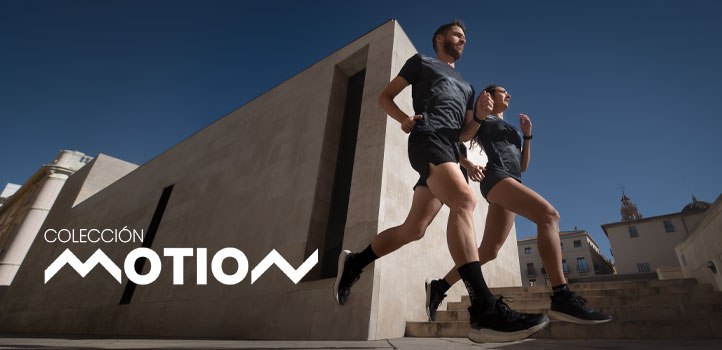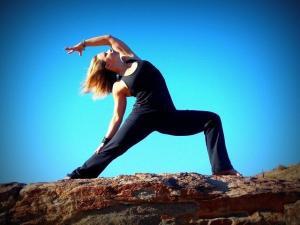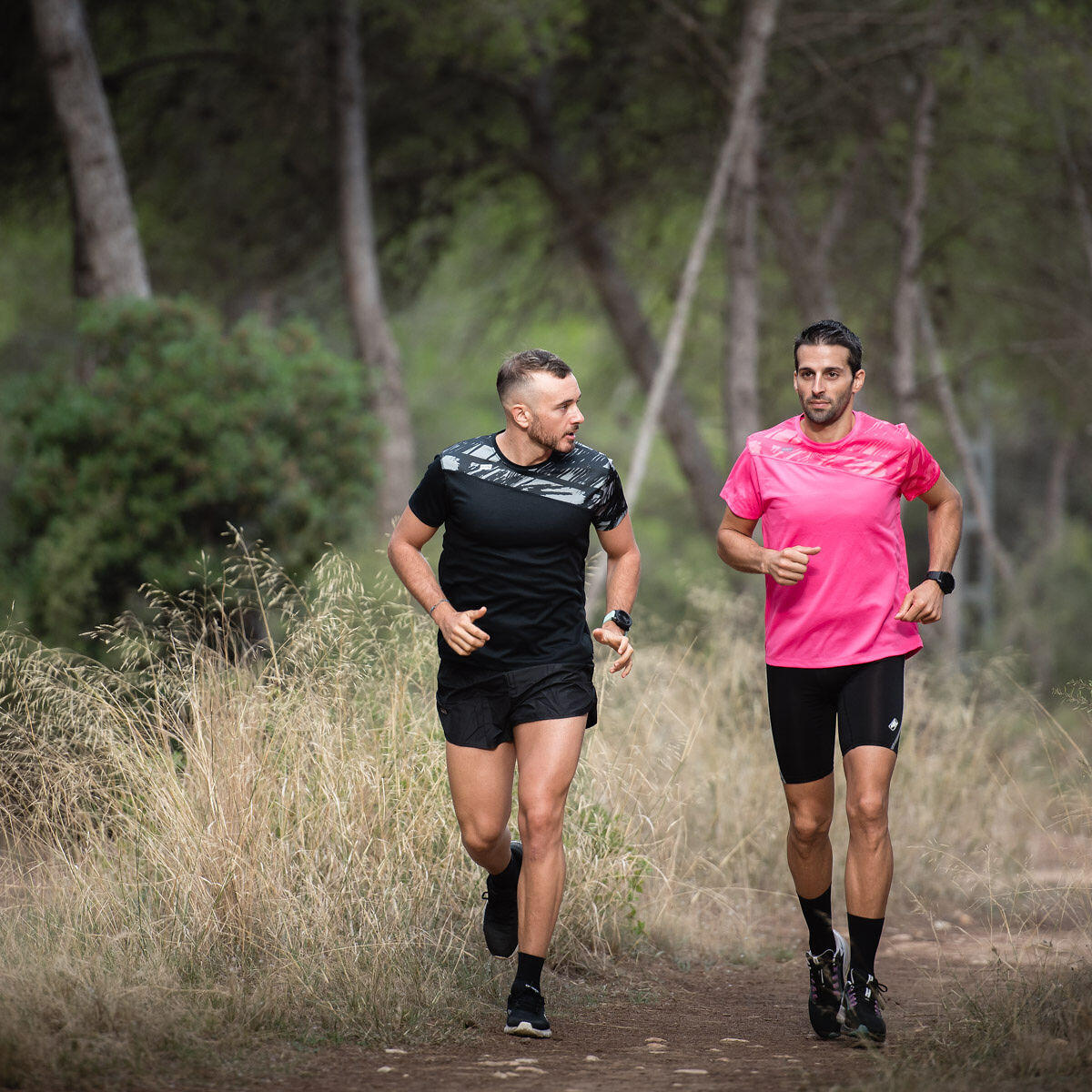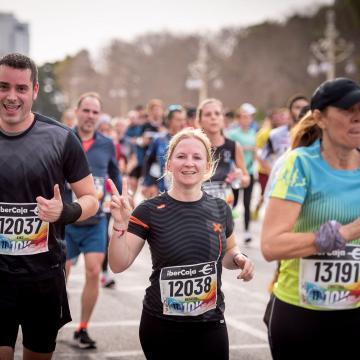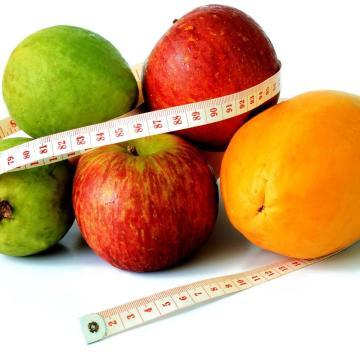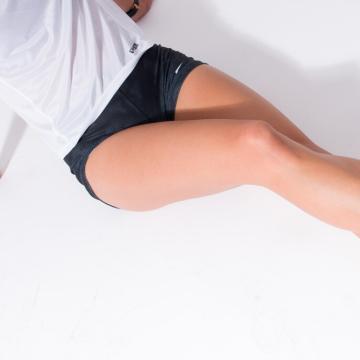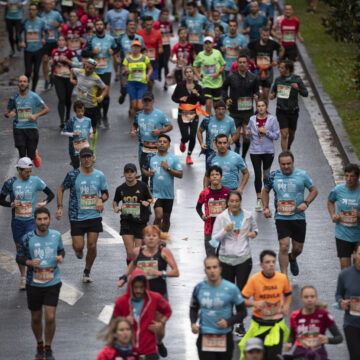Subscribe to our newsletter to find out about all the news and promotions, and automatically receive a welcome discount coupon in your email.
post -> Do compression garments improve sports performance?
Next, the effectiveness or not of compression garments, such as compression stockings or tights, is analyzed., to improve the sports capabilities of popular runners and thus increase the sports performance.
For several years now, the use of compression garments has been spreading, not only as sportswear, but also as medical treatment. In sports disciplines such as running or between is used in the form of compression stockings or compression socks / calves. Since the 90's, its use has begun to be applied intensively in sports activities and various studies have begun to emerge on its effectiveness (or not) to improve performance in various disciplines.
Sports performance and use of clothing compression technique
Several studies affirm that the muscular compression by means of tights or compression pants improves the power of the vertical jump, increases its sports performance. Others have also found that it delays the onset of muscle pain. This is due to the use of compression products reduces the vibration suffered by the muscle when it hits the ground (which then produces the suffered by all, stiffness). By reducing this impact, you will be protecting the muscle so that post-exercise pain will decrease to a great extent. That is, post-exercise muscle recovery will be accelerated and even its use during physical activity itself, for example; through compressive thighs.
There are even physiotherapists and experts who recommend the use of these compressive garments when exercising. By doing so, you are providing the muscles with extra protection, thereby reducing the possibility of injury to them. Furthermore, in the event that an injury has occurred, such as a fiber break; The pressure they exert helps the muscle itself in its healing process and reduces the risk of worsening the injury.
And even its medical use (as previously mentioned; improves venous return) is also suitable for athletes, reducing the amount of blood in our veins and thus reducing muscle edema. In this way, you will be more comfortable when practicing high intensity exercise.
In addition, the use of compression clothing has been shown to have positive effects on muscle oxygenation reducing the stagnation of venous blood (poor in oxygen).
We must also take into account the importance of compression products being made of breathable material, to allow sweat to be eliminated while maintaining muscle temperature.
When going for a run, it is quite common to meet other runners who have decided to use these products, and everything that has been heard about them are positive aspects. Although there are points that still need to be investigated or that are not entirely clear, what is known today is that these types of products represent a great advance in the sports world. And without a doubt, optimize muscle efficiency and decrease post-exercise pain. Therefore, its use is recommended to prevent sports-related pathology and improve sports performance.
El sports performance of those who practice running It depends on many factors. One of them is his diet, since both the carbohydrates and the proteins of the alimeThese moments directly affect your ability to respond to exercise. If you start running, it is important that you take note of some recommendations on the alimentation of runners that will help your body not suffer from the effort made.
La eating of a runner must be healthy, balanced and offer enough energy to compensate for the energy expenditure suffered during exercise. Therefore, it is important that carbohydrates, especially pasta or rice, and proteins are the basis of your diet and that you eat at least five servings of fruits and vegetables a day.
As for alimehigh protein snacks fish, red meat or eggs stand out, although taking care in the way they are cooked. Preparing them on the grill, instead of fried, will help you reduce fat and to maintain your proper weight. In addition, protein should be consumed in training periods, but not necessarily just before a race.
Also, keep in mind that if you like to run regularly, a healthy diet will help you both to have the energy you need to move and to avoid health problems derived from straining your body too much without providing it with the proper 'fuel'. The carbohydrates they will make your muscles have glucose they need to move and proteins will help repair and develop them properly.
Finally, it should be noted that you can also prepare the night before, choosing a carbohydrate menu with fat-free proteins, such as pasta with salmon. On the same day, you can have oatmeal with a banana to ensure your energy supply and, if you run more than 90 minutes, opt for nuts or energy bars that allow you to keep going.
We leave you a link to a article What a date 7 tolimesnacks with a high percentage of protein
If you want to read more nutrition tips you can do it in this link
El sports warm-up It has the purpose of getting the body progressively to reach an optimal level of physical fitness, obtaining greater mobility and flexibility in the joints, by performing a series of exercises, the immediate objective of which is to cause an increase in muscle temperature and thus when starting any activity we can perform to the maximum and also be in a position to prevent possible injuries.
Types of sports warm-up depending on the objectives
- El General sports warm-up prepares the body for normal physical activity with exercises of low specificity and preparatory intensity and must be adapted to the individual, progressive in intensity and prolonged for the necessary time.
- El Specific sports warm-up It is aimed at preparing the body for the practice of specific activities and deals specifically with the specific preparation of one or more parts of the body. Among the specific warm-ups we can include the dedicated to the different sports, consisting of a set of exercises, gradually ordered and aimed at all muscles and joints involved, in order to prepare the body for better physical performance.
In many sports, the sports warm-up is done with the same instruments that are going to be used in the execution of the main activity.
All warm-ups have an important preventive function, by trying to minimize any type of injury that may occur during the exercise, but we call preventive warm-up which is carried out in the recovery processes of an injury and is usually accompanied by massages and hot / cold baths.
Cooling
The main objective of the cool-down is to relax the muscle tone after the overload that the training has caused us. In this way, we achieve complete muscle relaxation and prevent us from resenting the effort the next day.
It is advisable to jog for a few minutes after training and then do some very gentle stretches.
Benefits of sports warm-up
- Increase in the temperature of the muscles involved and of the body in general, which in adults can rise above 38,5º
- Increased general blood flow and muscles in particular, which means increasing the supply of oxygen and improving the elimination of carbon dioxide.
- Increased heart rate and lung activity, improving its capacity and the use of oxygen.
- Increased performance and speed of muscle contraction.
- Improved reflexes and activity in neural circuits in the transmission of nerve impulses.
- Increased capacities of all sensory organs.
- Improvement of the general metabolism, ordering the different sources of energy.
- Increases the capacity for attention, concentration and information processing.
- Increase in general organic capacity, muscles and joints.
- Increased strength and physical dexterity, with decreased muscle tension, by improving oxygenation and increasing blood supply.
- Increased body temperature and improved synovial viscosity to facilitate joint and muscle sliding.
- Increases muscle elasticity and prevents sudden strains and tears, because the contraction and relaxation of the muscle, during exercise, improves speed and efficiency.
- Adapt and improve learning in the face of new circumstances experienced.
- long mesh running-unisex training.
- Lightness and comfort due to its perfect fit.
- Adjustable to waist size.
- Optimum breathability and sweat evacuation.
- Logo 42K gummed.
- Zippers with reflective bands at the bottom of the legs.
- Back zippered pocket for small items.
- It is not a compressive and/or thermal garment.
Eating correctly is key to improving as a runner. It may seem obvious, but reality shows us that things are not always clear. It is very common to find runners with many doubts, erroneous beliefs or confusion about what correct nutrition should be to achieve adequate and correct sports performance.
Training is the basis of improvement in any sports specialty, but in order to obtain effective benefits from training, you must follow a correct procedure.limentation.
On too many occasions there are popular runners who care a lot about how to train to improve times or face the challenges of long-distance races, but they neglect or do not give due importance to proper training.limentation.
Eating correctly has benefits in health, sports performance and physical appearance
Why and why is it important to eat correctly? Eating correctly provides benefits in three very important areas, ordered according to their importance as follows:
- Health.
- Sports performance.
- Healthy physical appearance.
When looking for reasons or reasons to eat correctly we should always be clear that the main priority is health, secondly sports performance and thirdly having a healthy physical appearance.
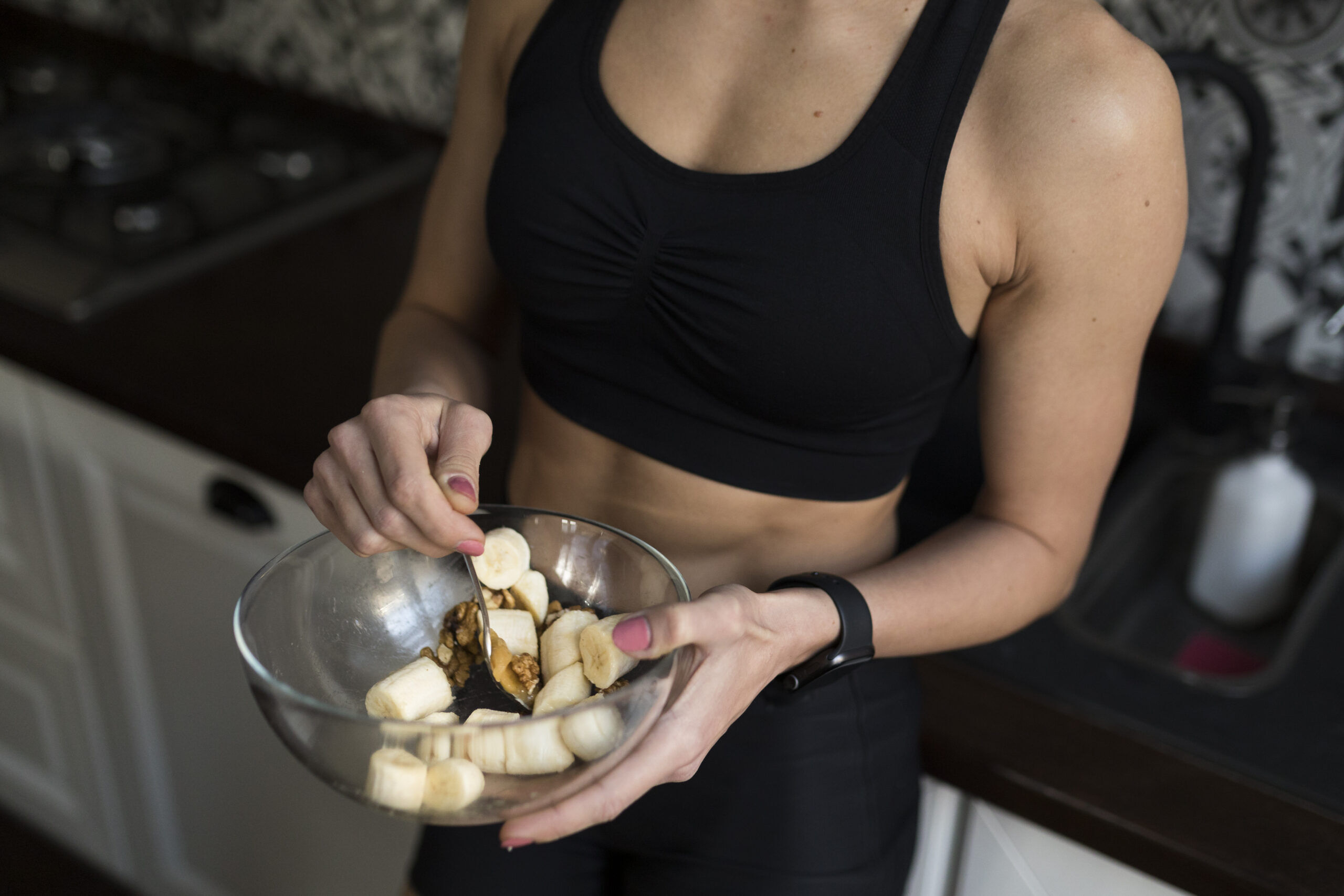
Have some good nutritional habits It will provide benefits at different levels for health, sports performance and a healthy physical appearance. Let's see the most notable ones below:
Decreased risk of pathologies. With a good nutritional status, the chances of suffering from pathologies such as Hypertension, d, hyperuricemia, hypercholesterolemia, hepatic steatosis, etc.; and if they already suffer (and are not acquired through family genetic inheritance), it is possible to reverse them and make them disappear.
Health & Wellness. Reducing the risk of pathologies is promoting a optimal health for any patient (men, women, athletes, pregnant women, nursing mothers, the elderly, children, etc.), which represents a considerable increase in quality of life as well as economic savings due to lower spending on drugs.
Weight loss. Evidently, eating correctly following a correctly designed (and followed) diet, moderately hypocaloric in nature, has a loss of fat mass.
Increased muscle mass. A dietary plan proposed in harmony with the training plan established by a coach allows the athlete increase your muscle tissue. Eating correctly in combination with good training focused on the established sports objective will mean a healthy physical appearance.
Post-workout recovery. Eat correctly under correct guidelineslimentaria will help recover muscle glycogen stores, regenerate broken muscle fibers during training, etc. If a runner makes the mistake of neglecting his or herlimentation, you can end up showing wear and tear and the demands of training; without a correct alimentation, sooner or later, feelings of weakness or fatigue will appear, which will mean loss of sports performance.
Preparation of competitive appointments. Eating correctly throughout the season, and specifically the week before a competition (especially the day of the test) is essential for correct sports performance, whatever the sport practiced. The difference between getting on the podium or not, improving personal bests or finishing with more energy than rivals is in thelimeTraining (and at the training level, obviously).
Increased athletic performance. SlablimeThe things that are ingested are the gasoline that is provided to the body to make an effort (among many other functions). A supercar uses 98 unleaded gasoline, not diesel, so if you want to perform, you will have to give your body 98 unleaded gasoline, that is, a alimehealthy eating and perfectly designed based on sex, age, type of sport, work and training schedules, blood test results, pathologies, needs and tastes, etc.
Lesions decrease. It is clear that eating correctly will not prevent you from spraining your ankle while running because of a pothole or a rock, or it will not prevent you from dropping a dumbbell on your foot in the gym and causing an injury. However, a diet that provides the necessary energy, as well as the recommended daily intakes of all the essential nutrients, is capable of avoid the appearance of cramps or jerks, therefore increasing sports performance.
Eating correctly does not have to be confused with eating less.
Sometimes there is a false belief that eating correctly means eating less, but in reality what it is about is eating well.
When a person decides to lose weight (reduce fat mass) one of the first decisions they usually make is to cut back on daily calorie consumption. Is it a correct decision? The answer to this question requires a prior clarification: to achieve a weight reduction (fat mass) a negative caloric balance must be generated, or what is the same "burn" with physical activity more calories than consumed in the different intakes.
To achieve this negative caloric balance there are several ways:
- Reduce the amount of kcal ingested on a daily basis.
- Increase our daily caloric expenditure.
- Merge both options: cut back on intakes and increase physical activity
In most cases the best option is increase exercise and not just reduce calories without further ado. Although it is advisable to individualize and personalize each case (because each person may have personal and specific circumstances); In other words: what a runner says he or she does through their social reds cannot be generalized as what is ideal for anyone.
Reduce without any criteria the quantity and/or frequency of intakes can be harmful to health since you can fall into macronutrient (carbohydrates, proteins and fats) and/or micronutrient (vitamins and minerals) deficiencies. This is a bad decision because it can cause various damages: tiredness, fatigue, bad mood, hypoglycemia, anxiety, decreased athletic performance, anemia, easier to fall ill (the immune system is weakened), etc.
Furthermore, and as stated in another article on this blog Losing weight in the middle of the competition season can be a bad decision. It is not advisable to undertake a weight loss strategy during the competitive period because it will be difficult to obtain benefits and sporting performance will surely be harmed.
On the subject oflimentation to reduce fat mass (weight loss)The best advice that can be given is go to a registered dietitian-nutritionisto to be in charge of designing a dietary plan adjusted to the needs, lifestyle and sporting demands of each person. A dietitian-nutritionist will always look for the best option to allow the person to achieve their sporting goals but always having as the highest priority the improvement of health through correct nutrition.limentation.
Remember, it's not about eating less but about eating correctly. You can reduce body fat with something as easy as doing frequent physical activity and eating correctly: eating a healthy, varied and balanced diet in which no group of foods is eliminated.limentos (consume meat, fish, eggs, fruits, vegetables, nuts, legumes, pasta, rice, dairy products, bread...), but in which the foods are clearly limited.limeultra-processed nts.
Forget the 'beats'limentos'; eating correctly is eating everything in the right amount
If you are a popular runner and you care about your nutrition, you have probably heard of the term 'exceed'.lime'ntos'.
If we had to define what the exceedslimein it would be something like “those toliments that have the capacity to cover all the energy and nutritional needs of the individual.”
But does anyone believe that alimeHow much can it have the capacity to cover all the energy and nutritional needs of the individual? Well no. The term 'exceedslimento' should not exist, however we can talk about itliments that have “X” capacity on health.
Avocado is good for the heart and has been considered a 'superlimento'. Indeed, numerous studies conclude that adequate consumption of said alimento contributes to a good state of cardiovascular health, improving blood levels of cholesterol, triglycerides, etc. Does this mean thatlimeIs eating avocados good for your health? No; someone who only knowslimeIf you eat avocados, you will probably end up suffering from hypoglycemia and you will always be exhausted, anxious, hungry, etc.

Eating correctly is consume theliments of all kinds in their right measure. You should not abuse alimenot because they say it is good, nor radically avoid othersliments. Would you like to eat a donut one day? (not every day of the week)? Forward! Food is one of the great pleasures in life.
Therefore, rather than talking about surpassinglimewe should do it exceedslimentation, which would be defined as a style oflimentation in which all groups oflimein (dairy, bread, pasta, rice, legumes, nuts, fruits, vegetables, meat, fish, eggs, etc.) and allows the individual to achieve a correct nutritional and health status.
In other words: One tolimento, no matter how good it is, is not capable of covering all the nutritional needs of a person, while onelimeVaried and balanced nutrition allows the person to achieve the recommended daily intakes (RDI) and maintain an adequate state of health. Eating correctly is, in short, having alimeRich and varied nutrition that optimally covers the needs that we may individually have based on our age, sex, state of health and demands related to the physical activity we perform.
Gastrointestinal problems are one of the main risks (and fears) that runners face in background tests like the marathon, trail races running long distance or ultra-resistance tests (6H, 12H and 24H).
The appearance of gastrointestinal problems dDuring a competition it can spoil all the chances of achieving the desired sporting goal. Most runners have experienced the difficulties and annoyances representing running with gastrointestinal problems, especially when this happens in tests lasting several hours (as is the case of the marathon, racing mountaineering, triathlon events, duathlons, etc.) in which the intake of alimentos, supplements, liquids, etc. to maintain sporting performance and avoid the dreaded “birds" as the hyponatremia.
Between 30% and 50% of runners suffer gastrointestinal problems in long distance events
Alimenting and hydrating correctly is necessary, essential to be exact, in races of a certain duration, but it is of great importance to do it correctly to avoid the appearance of gastrointestinal problems, which tend to be, as already indicated, very common.
Studies show that between 30% and 50% of the participants in long distance tests suffer from gastrointestinal disorders or problems. Fortunately, the majority manage to complete the course with more or less success, but it is also true that sometimes gastrointestinal problems can force abandonment because they trigger more serious consequences and put the athlete's health at risk.

We present below some of the most common symptoms gastrointestinal problems What runners can suffer during a long-distance event (and I am sure that the vast majority of runners have suffered some of these gastrointestinal problems at some point):
- Refluxes/burning.
- Eruptions.
- Distension/swelling.
- Stomachache.
- Nausea/vomiting.
- Intestinal cramps.
- Stabs.
- Flatulence.
- Gases.
- Urgency in defecation.
- Diarrhea
- Intestinal bleeding.
Running for hours with any of the gastrointestinal problems listed can be, at best, uncomfortable, although the discomfort can turn into major complications (lack of strength, dizziness, anxiety, abdominal pain, cramps...) and even lead to make the aspiration of crossing the finish line extremely difficult.

Main risk factors for gastrointestinal problems
Some of the gastrointestinal problems mentioned can be prevented. There are a series of factors that increase the risk of suffering from these disorders. Listed below are the main risk factors to suffer from these disorders in long-distance runners.
- Age. The appearance of gastrointestinal problems is more common in young athletes.
- Sex. The appearance of gastrointestinal problems is more common in of (especially during the menstrual period).
- Training level. The appearance of gastrointestinal problems is greater in athletes during their period of initiation to the competition.
- Pre-event intake. To avoid the appearance of gastrointestinal problems, it is recommended avoid fat and fiber. Consume carbohydrates (not whole grains) and protein. (This point will depend on the tolerance of each individual).
- Caffeine. It may be important for performance, but it is necessary control doses pre-competition and during the test, or even divide them into 2 shots.
- Dehydration. It usually occurs in the final part of races and is related to the appearance of gastrointestinal problems. Replace fluids and minerals It is essential during the race to avoid the dreaded dehydration that can destroy all hopes of reaching the finish line.
- Consumption of gels, bars, rehydration drinks,limein, etc. Must be test exhaustively in training individual tolerance of each and every product that will be consumed on the day of the race. On the day of the race you cannot do experiments: all thelimeThe liquids and solids consumed must have been previously tested in training to know how the body tolerates them.

Recommendations to avoid gastrointestinal problems
The following recommendations are of a general nature and may vary according to each athlete, type of sport, duration and intensity of the event, weather ... But they are a factor to take into account to prevent gastrointestinal problems:
- Always try the strategieslimentation and hydration in training and never on the same day of the race. If the sporting goal is a marathon, my recommendation is to try the strategy oflimentation and hydration in training and if the result is satisfactory, then try it in a test prior to the marathon that we have as our objective. Once we have ensured that it does not cause us any harm either in training or in competition, we can carry out the strategy in the objective test without fear of the appearance of gastrointestinal problems.
- Carbohydrate intake. ingest 60-70g of carbohydrates (HC) for each hour of competition. This amount can reach 90g HC / h according to the tolerance of the individual. In running races, the intake of 40-60g HC / h is recommended.
- Hydration. ingest 500-700ml of liquid per hour.
- Sodium intake. Take between 250-350mg sodium per hour. Replacement gels, capsules or drinks are some of the possible ways to consume it.
- Caffeine. Consume between half an hour and one hour before the start of the test. 2-3 mg of caffeine per kg of body weight (For example a 70kg runner will consume 140-210mg of caffeine in the test). If the race lasts more than 8-9 hours, this amount can be repeated every 3-4 hours.
- Consumption of supplements. Bars, gels, replacement drinks, etc. They are a great way to obtain carbohydrates, liquid, caffeine and minerals due to their easy consumption, digestion and absorption. Note: supplements in gel format should be taken with water to facilitate swallowing and dilute the concentration of sugars.
The risk of dehydration in the running It is an issue that should concern any person who runs, especially when running competitions of a certain distance (or duration) and with more reason when they are held in summer or in wet weather.
Dehydration occurs when the person you lose more fluids than you take in and that ends up leaving your body without enough water so that it can carry out its functions normally.
The correct development of all vital functions depend on, Inter alia, proper hydration. With prolonged exercise, water loss through sweat and urine is very high. And this also increases significantly when the temperature is high as it happens during the summer or in humid environments. The risk of dehydration must be considered whenever intense and prolonged sports activity is carried out, but especially when it is carried out in summer because the risk increases.
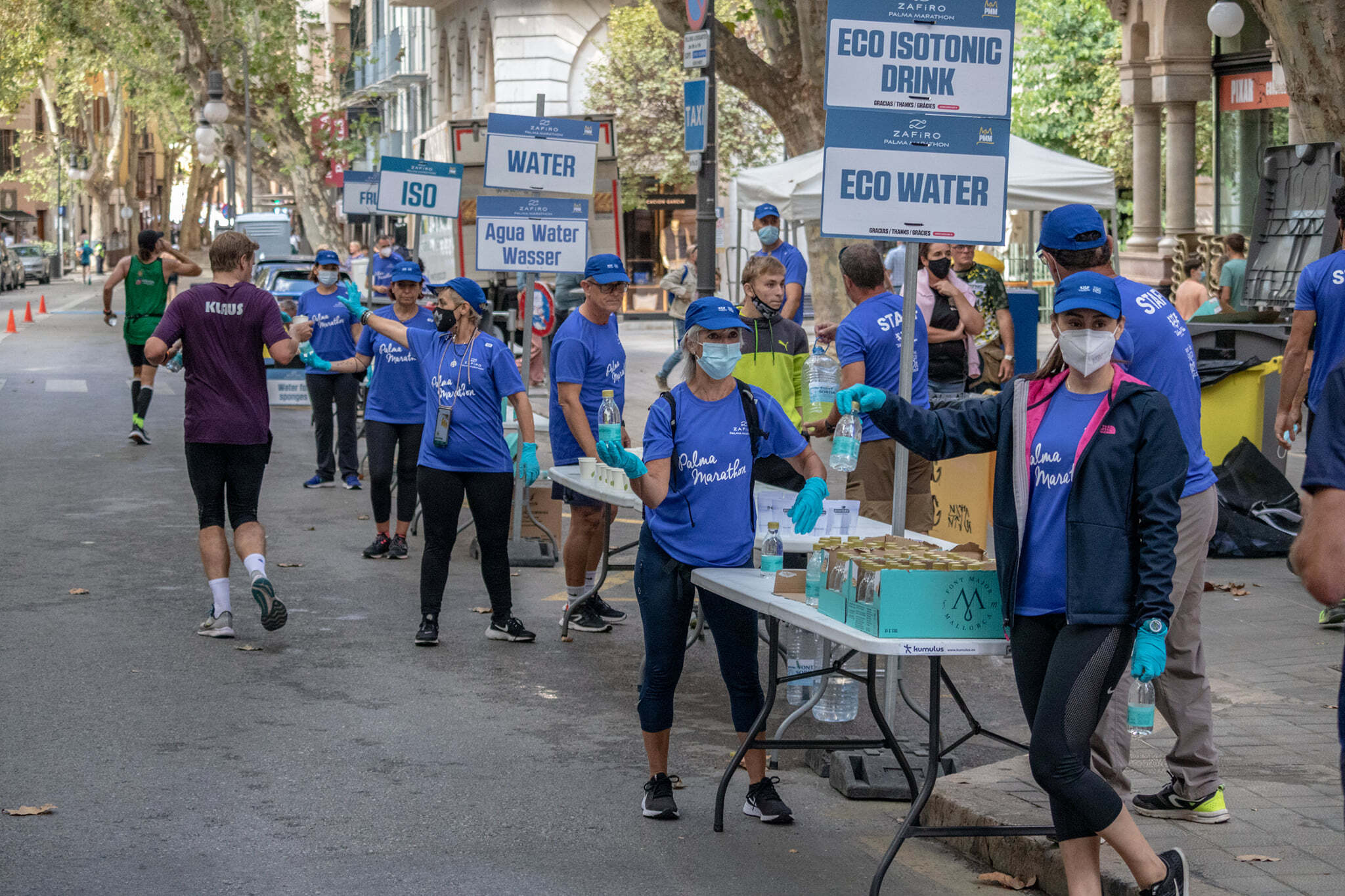
Dehydration, an enemy to fear
dehydration is one of the enemies that runners face in any long-term race from the second hour of competition. And he is not just any enemy, he is an enemy to be taken very seriously.
One of the main reasons for dropping out of endurance sports it comes hand in hand with inadequate or insufficient hydration or both.

It is common for dehydration to cause withdrawal from the marathon and trail races. running in which the 2-3 hours of competition are exceeded, however it is avoidable and many times it is produced by the athlete's mistakes.
First of all, it is remarkable that not only it is necessary to be properly hydrated at the time of the sports event, but in the athlete's day-to-day. It could be said, therefore, that incorrect hydration is one of the limiting factors for proper sports performance, post-training recovery, and prevention of complications during competition.
As already mentioned above, the main causes of dehydration are the sweating and urine (ie, situations in which fluid is expelled from the body). These situations vary according to weather factors such as temperature, humidity and wind.

Symptoms and consequences of dehydration
The first symptom dehydration in a competition can appear when the problem no longer has a solution; and this is so because it is possible that the athlete has previously overlooked symptoms to which he has not given adequate importance: thirst, less frequent urination, darker urine, Fatigue… As the degree of dehydration increases, these symptoms can be complicated by lack of energy, dizziness, confusion, altered heartbeat, nausea…
Some consecuencias dehydration are as follows:
- Cramps: Appearance of painful spasms in the muscular area of the abdomen and joints, caused by an incorrect sodium replacement. In other words, an adequate amount may have been drunk, but not correctly.
- Syncope: it is characterized by appearing in the first days of training in an environment with a higher temperature and humidity than usual. After a week the body acclimatizes to the new weather conditions.
- Exhaustion: appearance of gastrointestinal complications (nausea / vomiting / diarrhea), feeling of heat in the head and trunk, fatigue, hyperventilation. It usually involves the withdrawal of the test due to the inability to continue doing physical activity.
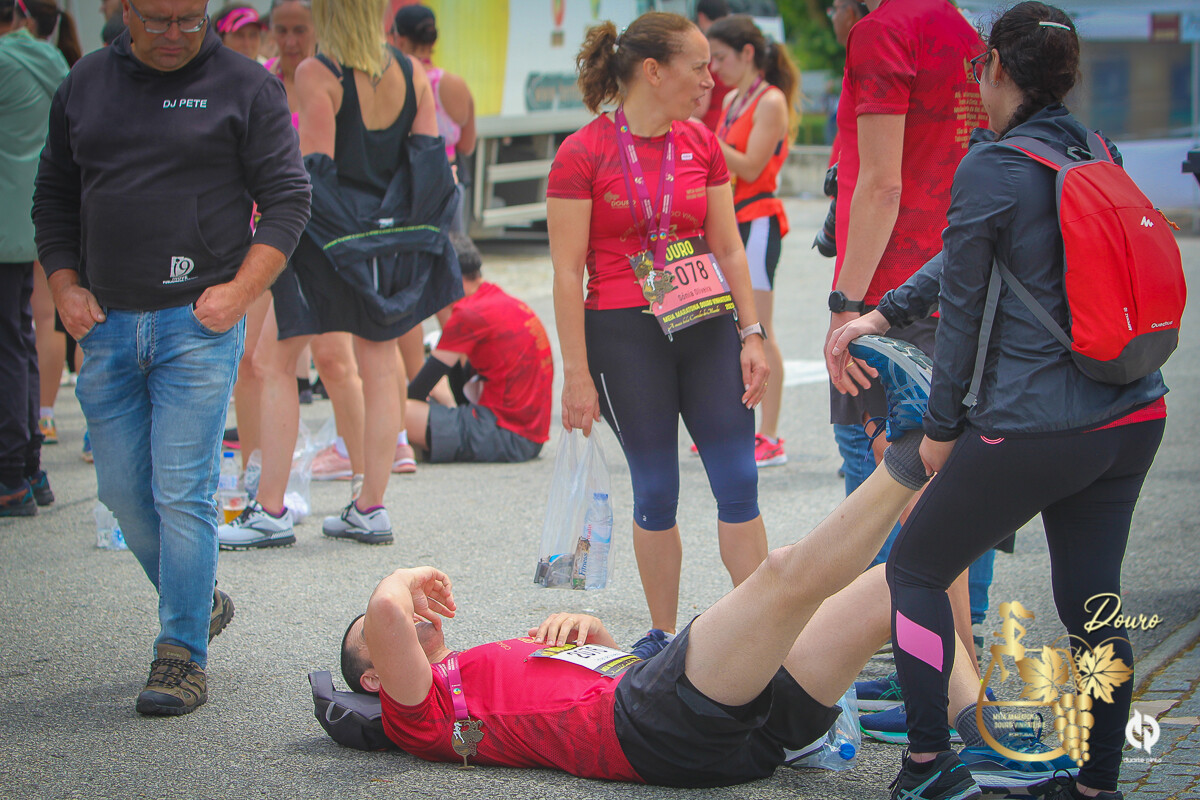
Hyponatremia, what is it and how is it produced?
La hyponatremia is one of the main complications in endurance and ultra-endurance athletes. An athlete suffers from hyponatremia when he presents a lower than normal blood sodium concentration. It is highly characteristic of tests lasting more than 6 hours, although it can also appear in periods of 2 to 4 hours of activity.
In this asymptomatic phenomenon and, therefore, difficult to detect, which in extreme cases can have serious consequences and even the death of the athlete. Luckily, such extreme cases are not usually reached and a good hydration strategy prevents its appearance.
The causes of hyponatremia They are basically these:
- excess body water: occurs due to excessive water intake or poor excretion.
- Decreased sodium in the blood: Produced by excessive sweating and poor replacement of said mineral.
In other words, there are times when, despite drinking a significant amount of water, you are not properly hydrated. And the problem is caused by a lack of sodium. It is not enough to replace the water to compensate the loss that is generated through sweat and urine, also it is very important to replenish sodium through salt capsules or rehydration drinks (water can be alternated with this type of drink).
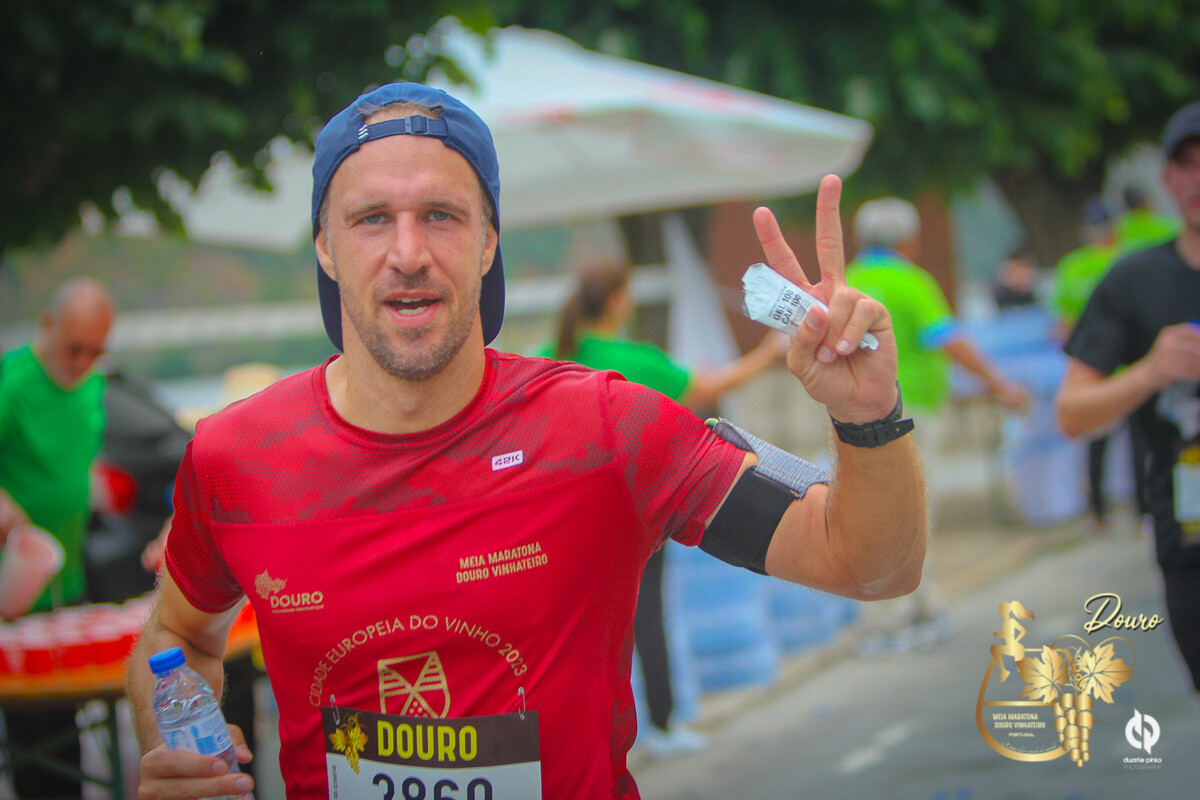
As a general recommendation, it could be indicated that adequate hydration would range from a consumption of between 500-700ml of liquid per hour, but we are going to try to personalize it a little more with a practical example of how to do it:
A runner wants to know how much he should hydrate during a marathon (starting at 9.00:15 a.m. with a temperature of about 3 degrees) and what he expects to do in 1 hours. A few weeks before the marathon, he should go out for a 9.00-hour run, at 75:60 a.m. with a temperature and pace similar to that of the day of the test. Just before going for a run, he weighs himself and records a weight of 74,2kg. During the hour of training he hydrates normally and after 0,5 minutes he comes home and weighs himself again, registering a weight of XNUMXkg; he looks at his bottle and sees that he has drunk half a liter of water (XNUMX kg).
Thus, in one hour the athlete has to replace 1,3kg of liquid for optimal performance. The equation is INITIAL WEIGHT – FINAL WEIGHT + INGESTED LIQUID.
Lastly, I would like to underline that nutritional planning in endurance/ultra-endurance events is complex, since multiple variables must be taken into account such as sodium and other mineral intake, carbohydrate intake per hour, fluid replacement, gastrointestinal problems, possibility of intake of alimeDrinks/liquids, supplies, type of sports, personal needs, sports equipment available to the patient, etc.
Therefore, on behalf of all registered dietitians-nutritionists, he wants to recommend to any runner who plans to face a long-distance race that they put themselves in the hands of professionals. Because from the hand of a specialist in sports nutrition you will know how to plan your hydration correctlylimentation facing your sporting goal without putting your health at risk.
Having a good body composition is essential to obtain or pursue optimal sports performance. For this reason, many athletes decide to lose weight to refine and improve their sensations in training and competitions.
However, when it is advisable to try lose weight? The answer is simple: or before or after facing the season of competition. Which It's not advisable is to face a weight loss strategy during competitive period because hardly any benefit will be obtained and, with complete certainty, sports performance will be affected.

So, dieting to try to lose weight in the middle of the season (and therefore competing and demanding maximum performance from the body) is a bad idea because it will not bring benefits and, nevertheless, it will bring harm.
Losing weight during the season penalizes performance
Depending on the type of sport that is practiced, one or another body composition will be needed. For example, in sports in which strength prevails, such as weightlifting, a more voluminous complexion and great power at the muscular level are needed. Instead, in endurance sports (how is he running, cycling, triathlon, etc.) and resistance using strength (such as football, martial arts, tennis, etc.) a thinner and lighter complexion is required.

That is, to run a test like the marathon, the lower the weight of the athlete, the less the sensation of "carrying a backpack" that is suffered during the 3-5 hours (in the case of popular runners) of the race. . It is indisputable that body weight affects performance in the running (or running, as some prefer to refer to running) more than in other endurance sports such as cycling or swimming.
Getting to the right or optimal weight can be very beneficial for any regular runner who has competitive goals like a half marathon or marathon or a long distance trail event. Because with the right weight or optimum it is possible to obtain a better performance and, therefore, increase rhythms and decrease times, but it is also very important because decreases the risk of injury at a muscular and joint level and the athlete will suffer less during the competition.
Knowing all the benefits of running with the right weight and not with a few extra kilos, it is not surprising that this improvement in body composition is sought (lower fat mass and increase muscle mass). But is it advisable to start a treatment to lose weight at any stage of the season? My answer is resounding: NO.
A diet to lose weight worsens sports performance
If a weight loss diet is carried out, it should be done outside of the competition season or when we are not assuming highly demanding training.
The reasons why it is not advisable to go on a diet to lose weight in the middle of the season are the following:
- First of all, trying to lose weight must be ruled out to avoid a decrease in sports performance. Let's use an analogy: if a car spends €50 of gasoline to make a trip but only €30 of fuel has been refueled, there comes a time when the car stops. The same thing happens to the athlete: if thelimentation gives you less energy than you need, after 2, 3 or 4 weeks, your performance will begin to suffer and you will finally suffer a "puncture" in your performance; and from that moment on there will be little that can be done because your body will no longer respond correctly to the demands of the effort.
- In addition, between one training session and another you need a significant supply of energy and nutrients, which probably will not be achieved with a low-calorie weight loss treatment. For this reason, the athlete will not arrive fully recovered at the next training session.
- During training sessions and competitions, a constant supply of energy is necessary to maintain performance. If this is not the case, the athlete gradually decreases performance.
Lose fat in the middle of the season
But is it possible to lose or lose fat in the middle of the season? Yes, but trying not to lose weight.
If you want to lose fat in the middle of the season, it is advisable to have a weight maintenance diet and a negative caloric balance (i.e. spend more kilocalories than those that are ingested) introducing walks of more than an hour daily in a state of postabsorptive fasting, that is, allowing a few 3 or more hours after ingestinglimein (The postabsorptive state is the metabolic state that occurs after digestion, when ingested food is no longer the body's source of energy and depends on stored glycogen).
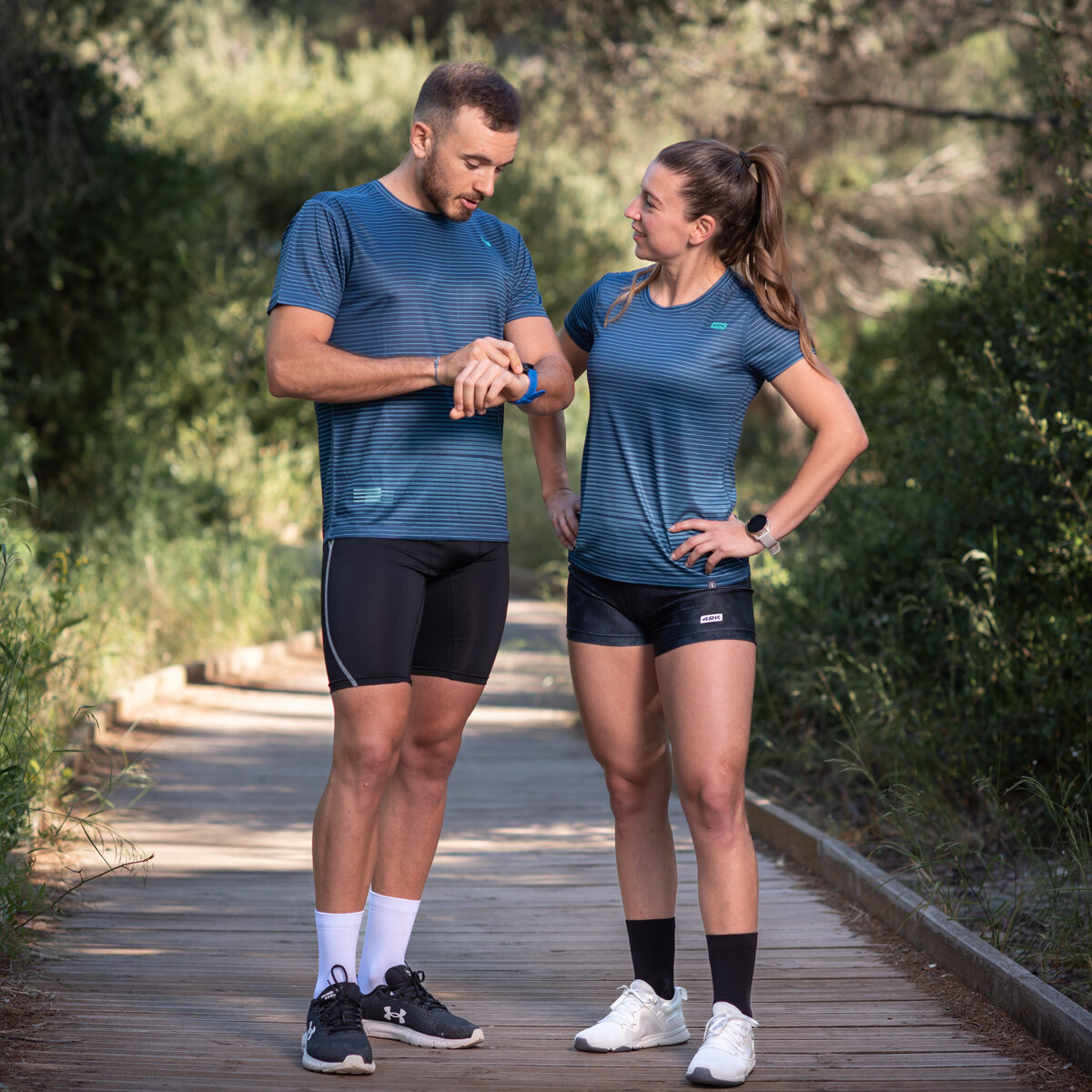
Therefore, and by way of summary, the ideal is to carry out a weight loss strategy during the pre-season or after the competitive period has finished, but it should be emphasized that it is not a good idea to lose weight in the middle of the season because the result will be disappointing.
Below you can see in the following infographic a schematic summary of what was explained above.
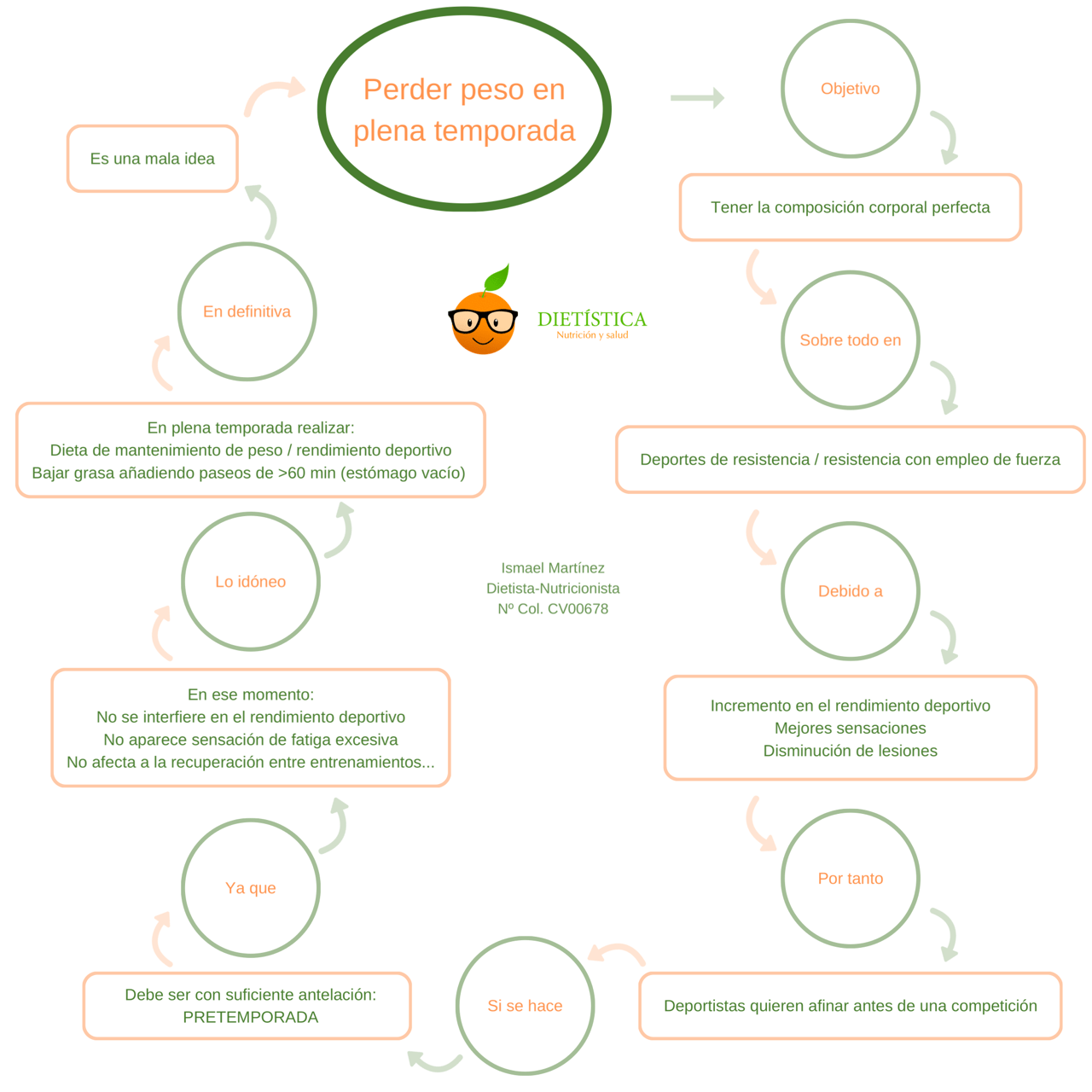
In a previous article on this blog I tried to answer questions about what to eat (and drink) before a competition. Now we are going to see a series of nutritional recommendations to recover from the efforts of a competition. In this article I am going to show you what to eat after a run.
All athletes know that once a competition is over it is really important tolimesit up correctly for recover all those metabolic fuels used in the test, but... what is the proper way to do it?
In this article we are going to see how intakes should be after a demanding competition that has forced us to make an intense and prolonged effort.
What to drink and what to eat after a race?
It is very important to ingestlimeAdequate times in the hours before a competition to obtain optimal sports performance and avoid possible discomfort that prevents you from competing at the best level during the race. But the intake after a physical effort is no less important because there has been wear and tear that can have negative consequences for recovery (and to a certain extent also for health) if it does not favor the replacement of all those levels that are important. .
The importance of knowing what to eat after a race is essential for proper recovery, especially when we talk about the physical efforts associated with racing. running or trail running.
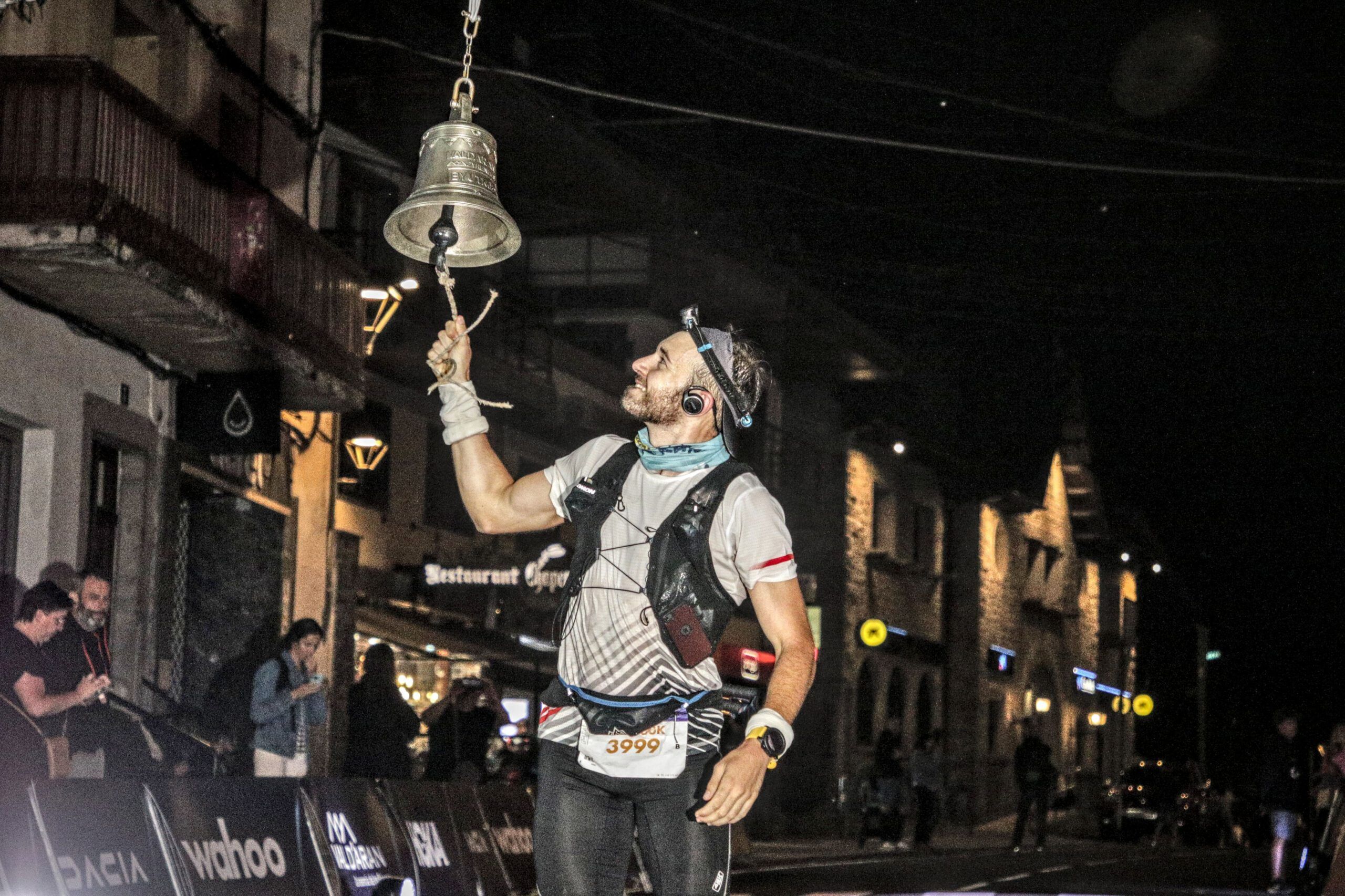
Glucogenic regeneration, the first thing
We will start by talking about glucose, a carbohydrate used as fuel by our body for physical activity and that is stored in the glycogen stores. Due to intense physical activity they usually end up practically empty.
We could say, therefore, that as a first response to what to eat after a race, would have to say that our tolimepost-competition performance should be focused on recuperación of sayings glycogen stores.
The replenishment of glycogen stores is quite slow. To get an idea, in the face of hypoglycemia (decrease in blood glucose commonly called "low sugar") it begins to recover from the first minute of ingesting alimeFoods rich in carbohydrates, such as bread, honey, jam, fruit, sugar... [Yes, we can takelimeSugary snacks considered unhealthy, since at that time we only care about avoiding fainting or possible medical complications]; however, glycogen stores may take time more than 24 hours to recover.
Recommendations for glycogenic regeneration
However, with a series of correct guidelines we can reduce the replacement time of glycogen stores to 12-24 hours. Let's go with some recommendations to achieve glycogenic regeneration:
- Firstly, No. it is convenient train within 48 hours to the competition, unless a low intensity activity is carried out. If we do intense physical activity, the body will continue to demand energy and will prevent what we are ingesting from serving to regenerate glycogen stores.
- consume thelimesnacks rich in carbohydrates during the 24 hours after the race. It is convenient that the intake of alimemeals rich in carbohydrates is carried out after a few 45 minutes after the end of the competition because in this way the recovery will be accelerated. That is, it is not only important whatliments to take, but when to take it is also important.
- The alimefoods rich in carbohydrates They are basic, but it is important to consume them without mixing them with fats and proteins, so that digestion does not slow down and therefore the absorption of nutrients and the filling of glycogenic deposits.
- In addition, given the great satiating power of the alimeFoods rich in protein and fat should be avoided in the first 6 hours after the end of the competition; The explanation of this recommendation is simple: if these are taken atlimeAt times it will be very easy to get satiated quickly, which will mean stopping drinkinglimentos rich in carbohydrates that are going to allow glycogenic recovery.
- But... what tolimeHow many are recommended for glycogenic recovery? Well, for example... fruits, miel, jams, rehydration drinks, potato, pasta, Sweet potato, rice, pan, juices, quince, vegetables, dried fruits...
- All of this in a white version (avoid wholemeal because its digestion is much slower and also its assimilation) and in the case of pasta and rice they must be very well cooked (not al dente), since the integral or little cooked are slower absorption.
- And it's not enough to justlimefoods rich in carbohydrates, you also have to include thelimefoods with high potassium content andliment liquids. For what reason? Well, because the liquid and potassium intake is necessary in glucogenic regeneration.
AlimeFoods rich in potassium and carbohydrates but poor in protein and fat
Many potassium benefits for the organism. It's a very important mineral for health and in addition to being very effective in avoiding muscle cramps (which is why most runners and runners appreciate it), it also helps prevent a wide range of problems such as high blood pressure, constipation, osteoporosis or cardiac arrhythmias.

It is recommended a daily consumption of about 3.500 mg of potassium a day, but in the case of glycogenic regeneration not all the alimePotassium-rich foods are ideal; We will see below a list of alimeFoods rich in potassium and carbohydrates but poor in protein and fat:
- Potato.
- Sweet potato.
- Banana banana.
- Kiwi.
- Dried peaches.
- Raisins.
- Dates
- Watercress.
- Spinach.
- Broccoli.
- Brussels sprouts.
- milk caps
- Scallions.
I hope these recommendations help you to know what to eat after a race.
One of the questions that friends who run have asked me many times is what eat before a race. In this article I am going to indicate a series of nutritional recommendations before facing a competition running.
What to drink and eat before a race?
It is very important to ingest alimesuitable nts in the hours before a competition to obtain a optimal sports performance y avoid possible discomfort that prevent you from competing at the best level during the race.
It is necessary to emphasize that the sports season has several phases (rest, preparation, competition and post-competition) and therefore thelimentation will not be the same at different times of the season.
It is also important when talking about what to eat before a race to differentiate between the needs of highly trained people (regular or elite athletes) and people who run for fun or leisure (popular runners and runners), since the energy pathways used during physical activity will not be the same. Obviously, any elite athlete knows what to eat before a race, but among popular runners it is common to find great ignorance.
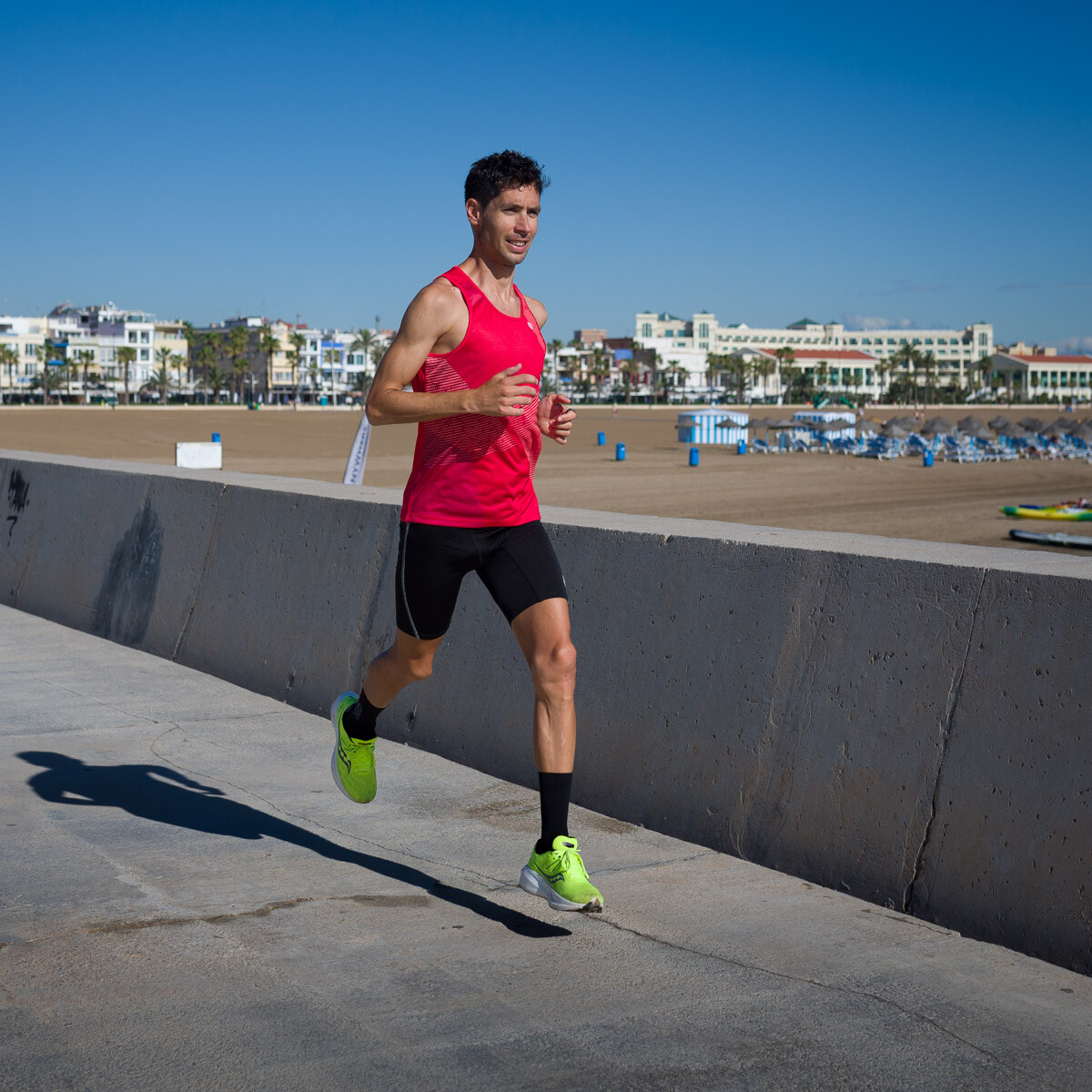
While the highly trained runner uses intramuscular fatty acid oxidation and is much less dependent on muscle glycogen (glucose store), the less trained athlete consumes a greater amount of carbohydrates (glucose) and a lower proportion of fatty acids. This supposes a lower sports performance in the case of the less trained athlete, because glycogen is very limited, while fatty acids can be used for a longer time.
Nutritional recommendations to face a competition
But what, when and how should we eat before a race? We are going to see the what, when and how of what to eat and drink before facing a demanding physical activity.
– About 3 hours before physical activity
3 hours before facing the test, a intake rich in alimefoods rich in carbohydrates (since glucose shortage is directly related to fatigue and decreased sports performance) and to a lesser extentlimented with protein, fiber and fat.
If we have the competition in the morning, my breakfast proposals would be the following:
- Milk or vegetable drink with cereals.
- Milk or vegetable drink with toast with honey.
- Milk or vegetable drink with oats.
If we have the competition in the afternoon, my lunch/meal proposal would be the following:
- pasta or rice (always white) with a small amount of vegetables and a little bit of tuna.

Why pasta or white rice? Well, because its digestion is much faster and therefore the assimilation of its nutrients is also much faster. Furthermore, to ensure correct and rapid assimilation, both pasta and rice must be well cooked and not "al dente" because it will be much more difficult to digest.
– Between 30 and 60 minutes before physical activity
The protocol at this time will start with 2-3 glasses of water about 15-20 minutes before making this intake to avoid slowing down digestion.
between the tolimeIn the absence of approximately 1 hour before the start of the test, it is necessary to include aliments of easy digestion as bread with honey, quince or jam; Skimmed yoghurts, non-whole grain cereals, low-fat biscuits, non-whole muesli, fruit or dried fruit.
All of this can be replaced by a few 300-500ml of isotonic drink rehydration sugar.
– Between 5 and 10 minutes before the start of the test
Ingest isotonic drink sugary orlimeFoods in small quantities that are very easy to digest, such as dried fruits. In case you do not consume isotonic drinks at the moment, take 2-3 glasses of water.
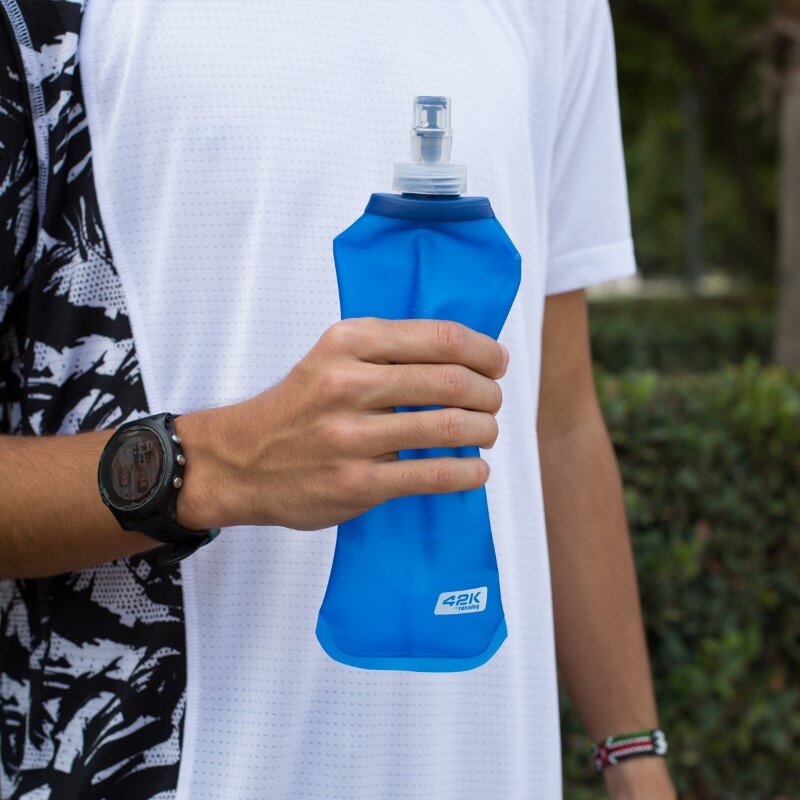
Everything must be trained before the race: also food and drink
A very important warning is that everything you eat or drink before the race must have been tried several times previously on training days. On the day of the competition you do not have to do experiments: no need to trylimeFoods or drinks that we have not tried before and we are sure that they feel good to us.
It is recommended try everything in training first and adapt these guidelines to our protocol. I give an example: the isotonic drink 5 minutes before the start may not feel good, but a handful of raisins and dried apricots do; Or that an hour before you don't feel like a jam sandwich but you do feel like some non-integral cookies. It is very important that each athlete knows himself as well as possible and knows with certainty what tolimeFood and drinks work for you and feel good.
None of the advice or recommendations on what to eat before a race that appear in this article (or in that of any other nutrition specialist) should be put into practice on the day of the race as it is possible for discomfort, allergies, intolerances, hypoglycemia...
I insist again that it is vitally important do not introduce changes or do tests on our a guidelineslimentation the day of competition because we can ruin the preparation of many months for a foolish thing. Not only do you have to train resistance, strength or elasticity, but also you have to train thelimentation and hydration, especially when we face tests that will require a prolonged and constant effort of more than 60 or 90 minutes.
Of course, you don't have to worry as much about what to eat before a 5K race as what to eat before a half marathon or a marathon. My advice to those runners who intend to prepare for a competition such as the half marathon or the marathon is to see a sports nutritionist for advice and guidance on the correctlimentation that they must incorporate into their planning for the sporting objective.
In this article you will know the 3 basic strength exercises for legs that are very recommended for runners; it is about the squats, scissors and bridges.
The trainer and physical trainer Marcos Greus (INEF graduate specializing in high performance) explains how to correctly perform these three basic leg strength exercises. “These are three very convenient exercises for all people who run because they help improve sports performance and prevent certain injuries”says Greus.
Squats, scissors and bridges, all 3 basic strength exercises for legs
Many runners who are new to running (or have been running for a relatively short time) have questions about what are the “must have” basic leg strength exercises.
There are many, infinite, exercises to gain strength in the lower body, but if I had to recommend three, I would especially for people who are starting out running or who have been running for some time and have not yet incorporated strength work into their training, without a doubt these would be:
- Squats (squats in English)
- Scissors or strides (lunges in English).
- Bridges (bridges in English).
These 3 basic leg strength exercises are the ones that, at least, every runner should include in their weekly training routine because they will help them run more efficiently, delay muscle fatigue, and also reduce the risk of injury. .
I highlight and recommend these three basic leg strength exercises for their effectiveness (they encompass all the muscles that intervene directly or indirectly in the running) and because can be done at home with your own body weight (after some time working with your own body weight you can start using additional weight such as weights, barbell, etc.).
El leg strength training, same as the core training, is important for the entire population (understood as efforts adapted to the age and personal circumstances of each person), regardless of whether or not they do sports, but it is Fundamental and indispensable for runners because, as has already been said, it helps to improve performance and to run more efficiently and safely because it reduces the possibility of overloads, discomfort and even injuries after a day of series or a long run.
Strengthening your legs is essential to enjoy the running on any surface, but it is especially important for running safely in the mountains. Trail runners running They must pay close attention to leg strength work because running on uneven terrain requires prepared muscles in the lower body to prevent problems in the ankles, knees, calves, hamstrings...
Basic strength exercises for legs: 1. Squat
The squat (or squat) is an exercise that works all the muscles involved in the race: quadriceps, glutes, hamstrings, twins and soleus.

Important things to keep in mind to perform the squat movement well: in the case of beginners, it is recommended that the first few times they perform the exercise with a chair or a bench behind them to lower themselves until they touch their butt (without leaning on it). or sit).
Another aspect to take into account is that you have to do the descent with the back straight and with the abdomen in tension so that the back does not suffer. A common mistake is to round or round the back, which puts undue stress on it.
Feet should be slightly wider than hips apart, with the balls of your feet straight or pointing slightly outward. It is important to keep your feet glued to the ground at all times; Avoid leaning your back forward so your body weight doesn't shift to the balls of your feet (this can be a bit hard to avoid at first, especially when working with body weight alone).
It is also important to perform the downward movement (inspiring the aire before starting) and rising (gently exhaling the aire) slowly, with an approximate tempo of 3 seconds to go down and 3 seconds to go up.
Benefits of squats:
- Increased strength and power.
- Increased coordination, balance and stability.
- Improved back posture. Squats work very effectively the abdominal muscles and back muscles (also known as the 'core'), which helps to have a better back posture and reduce the risk of discomfort or pain that the running May cause.
Basic strength exercises for legs: 2. Scissors
The second of the basic leg strength exercises is the scissors, also called strides or lunges. As with the squat, it is an exercise that can be performed in various variations, although in this case we are going to talk about the classic static scissors or stride.
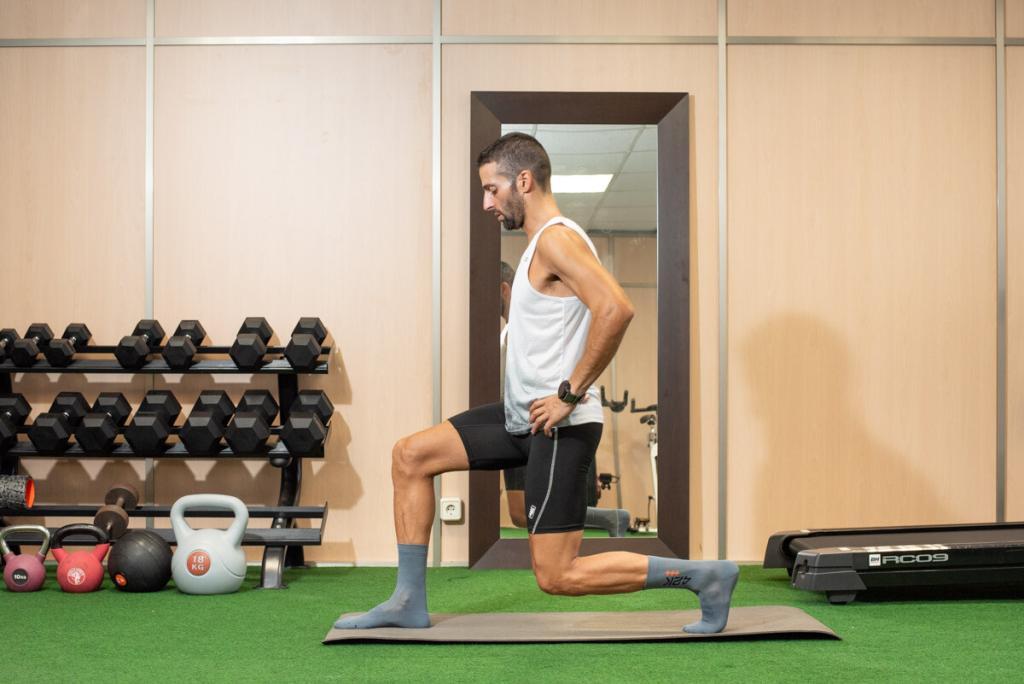
Like the squat it is a multi-joint exercise with which we are going to work various muscles, but with special intensity the musculature of the thigh and hip.
This is a one-sided exercise (The squat is a bilateral exercise) with which each leg is worked independently. For this reason, scissors require a bit more coordination and level of strength. At first it is normal for this exercise to be a bit difficult to perform without imbalances, but in a short time and with a little perseverance it can be done effectively.
How to do it? From a natural position, take a step forward with one of the legs and both knees are flexed until reaching an angle of 90 degrees; the back knee should not touch the ground.
The body is allowed to fall forward in a controlled manner, supporting the weight on one of the legs and returning to the starting position. The return to the starting position must also be in a controlled manner with the push of the leg that we have in advance.
Important things to keep in mind in this exercise: the fall must be smooth and with a controlled braking action of the lead leg. This braking action will involve work for the quadriceps, gluteus and hamstring. And a concentric phase back to the starting position.
It is very important for the correct realization of the scissors maintain the verticality of the body avoiding trunk oscillations; the back must be straight during the execution of the exercise, without arching. To avoid these 'instabilities' it is very important to have a strong 'core', which is why it is convenient that leg strength work is always complemented with core strength work.
Benefits of scissors:
- Increased strength and power of legs and buttocks.
- Increased balance and stability.
- Increased hip flexibility.
- Improved back posture. Scissors, as is also the case with squats, involve work for the abdominal muscles and the back muscles ('core'), which helps to have a better back posture and reduce the risk of discomfort or pain that the running May cause.
Basic strength exercises for legs: 3. Bridges
The bridges (or bridges in English) are a compensation exercise to work the posterior muscle chain, which is the one that suffers the most when long runs are made.
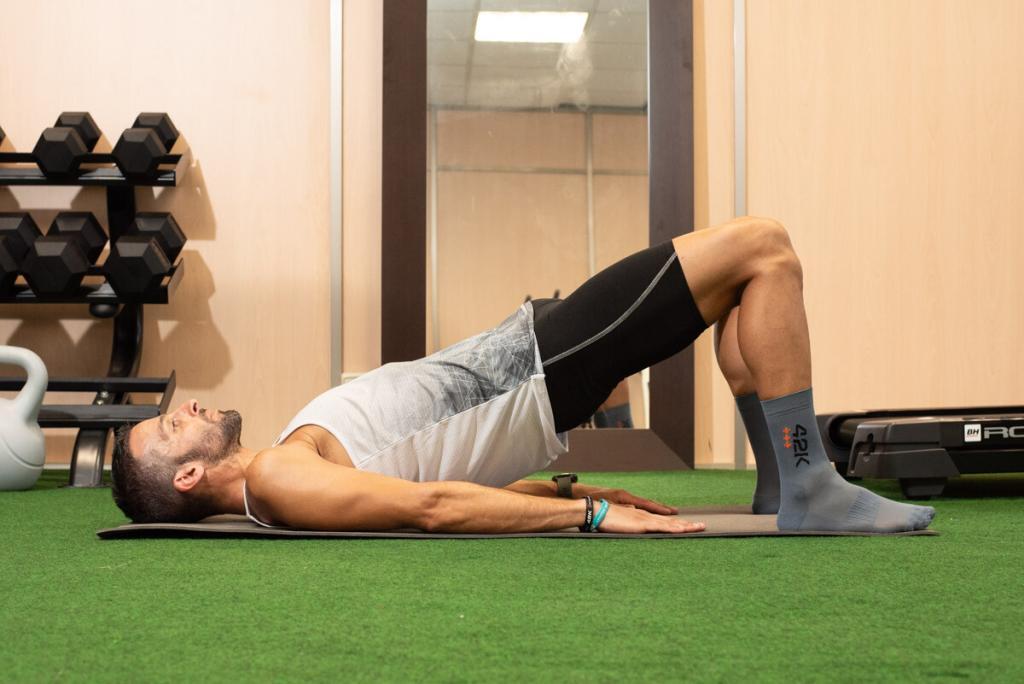
In general, when performing strength exercises for the legs, one can make the mistake of giving more importance to the work of the anterior face of the leg muscles but not so much of the posterior face.
The bridges are especially useful for working and strengthening the glutes, a very large muscle group that may not be given the importance it really has by people who run. In addition, this exercise works the lower back (core), hamstrings and hip muscles.
From a lying position, it is about resting the shoulder blades and the soles of the feet on the ground (with a separation of the width of the hips) and extending the hip, raising the hip upwards and returning to the starting position.
Important things to keep in mind when making bridges: keep the abdomen tense so that the back does not suffer and tighten the buttocks. It may seem like the easiest of the three exercises, but it requires good execution to be truly efficient. We must ensure that the scapulae (shoulders) are glued to the ground and that the spine is straight in a natural posture, without arching.
Benefits of bridges:
- Increased strength and power of the buttocks and lower back muscles.
- Increased balance and stability.
- Increased hip flexibility.
- Improvement of the upright posture of the back.
How to perform these basic strength exercises for legs?
Now you know how to perform the 3 basic leg strength exercises, but how often?
For people starting with strength work, my recommendation would be once a week doing 1 sets of 3 repetitions. In the case of runners who already have an advanced level, I find it very interesting to do these exercises before shooting, doing 15 sets of 2 repetitions.
Is the important strength training? The answer is a resounding 'yes'. What's more, I would say that strength training It is important for the entire population. (logically adapted to the circumstances of age, mobility and needs of each person) but it is essential for runners and runners of any level.
Anyone who runs regularly has to place a lot of importance on strength training.
Strength training to prevent injuries and gain speed and endurance
Only with stronger muscles can gain stamina and speed. If we want to improve as runners, we must include strength training in our routine or weekly training calendar.
In addition to helping us improve our sports performance, strength training will help us to Prevent injuries.
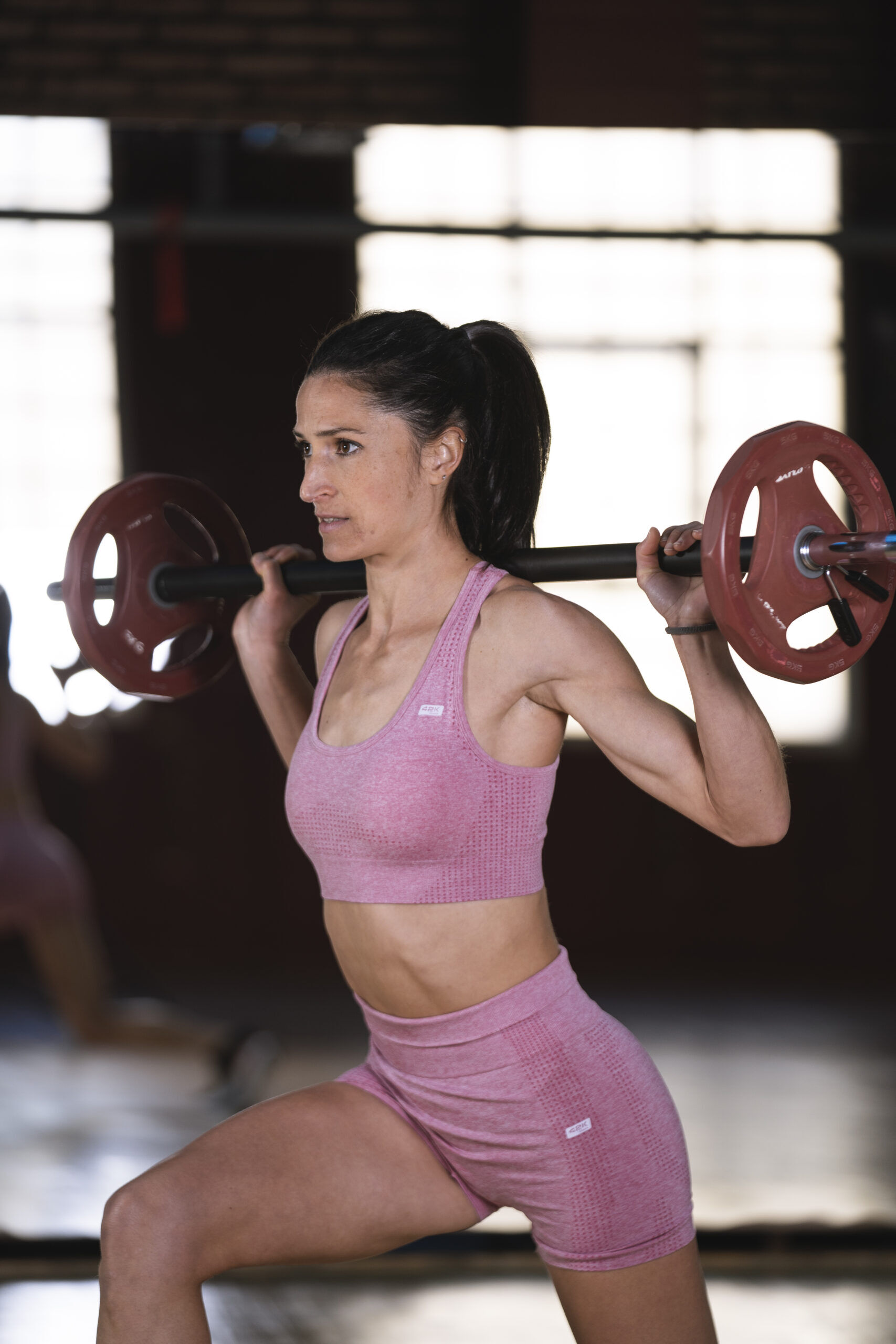
The benefits of strength training are many, but in the case of running They are fundamentally these:
- Prevent injuries. A strong musculature, in addition to protecting against falls, impacts, etc., also helps us to have better postural health in our daily activities (for example, sitting correctly) and when running. Many runners and runners suffer, for example, back problems due to the lack of adequate leg muscles that prevent them from maintaining a correct posture while running. A strong musculature contributes to the stabilization of the bones, which helps to reduce injury problems, joint pain, etc.
- Gain speed, coordination and power. Some people mistakenly think that to run faster you have to run more kilometers; It's sometimes surprising to see workouts from popular runners that have more miles per week than professional athletes, but don't spend a single day specifically working on strength, or at most include a hill session.
- be more efficient running. When strength training is given due importance and is worked correctly, greater efficiency is achieved when running; that is, with less effort you get better performance because you earn speed y resistance.
Strength training is beneficial for the entire population
In general, strength training has many benefits for the health of the entire population: kids, adolescents, adults and, of course, also for the elderly or the elderly population.
As pointed out by the National Committee of Child and Adolescent Sports Medicine (2018), there is scientific evidence on the positive effects of strength training in kids and adolescents; and they are these:
- Increased strength and power.
- Increased bone mineral density.
- Injury risk reduction.
- Improvement in motor skills such as running, jumping, throwing...
Regarding the elderly or the elderly population, there are many studies that in recent years have underlined the importance of strength training to have adequate muscle tone when reaching advanced ages.
Because it is the lack of muscular strength that prevents a large population of the elderly (and that are not even in the elderly) from having adequate mobility or from simple day-to-day functional tasks (getting up from a chair, climbing stairs , pushing the opening of a door...) become difficulties that generate dependency.
La osteoporosis and sarcopenia, two problems generally related to the aging process, can be prevented or at least minimized through physical exercise and especially regular strength training.
La sarcopenia It is the progressive and generalized loss of muscle mass that implies weakness and incapacity for mobility, which has as an immediate consequence the loss of quality of life.
La osteoporosis It is a disease that weakens the bones making them very brittle. Over the years, bone mass is lost, but it is after the age of 70 when the problem can worsen.
How to do strength training? If possible, with a sports training professional
We already know why you have to do strength training and now we are going to talk about how.
It has become clear how important it is to perform strength training if we really want to improve our performance as runners, but how to do it?
My first advice would be put yourself in the hands of a qualified professional to know which exercises can benefit us the most and to learn the correct execution technique for each exercise (what loads to use, how many repetitions to perform, how many series, how to combine the exercises...).
The guidance or advice of a sports training professional seems especially advisable if you have never done strength training before. A poor execution or incorrect combination of exercises can cause unexpected problems in the form of discomfort or injury.
And surely there will be someone who thinks “but a trainer or physical trainer is going to cost me money”; Yes, of course, but it is the guarantee of doing things well and that strength training really brings us the expected benefits.
In addition, strength training must be designed and structured for the needs or objectives of each person, hence the importance of having the advice of a qualified professional. Because strength training is not the same for someone who wants to prepare for their first 10K as it is for someone who has been running for a while and wants to prepare for the marathon or a trail race.running.
Strength training must follow phases or stages
Also, and this is very important, you have to follow an adaptation process; We cannot start strength training right off the bat without going through an adaptation phase (getting the muscles used to light weight exercises).
After the adaptation phase, it will be necessary to go through a general preparation phase (increasing the range of exercises and also progressively increasing the loads/weights) to finally reach a specific preparation phase, in which those muscles that may have the greatest importance when running (or that can help us most in pursuing a goal, whether in a 10K, a marathon or a trail testrunning ).

A piece of advice that I usually give after having overcome the adaptation phase is the performance of some tests that will help us to know where we start from. One could be the classic estimation 1 RM (Maximum Repetition); another could be the vertical jump test “Squat Jump” to determine the 'explosive force'.
Logically, to carry out and assess these tests we need a physical activity professional; Based on the results of these tests, the physical activity professional will be able to guide and guide us with strength exercises. The correct planning of strength training is essential to obtain the many and satisfying benefits that it can bring to anyone who wants to improve as a runner.
Strength Training Tips for Runners
Arrived here some reader or reader may think "And you're not going to give advice on which exercises are best suited for runners?"
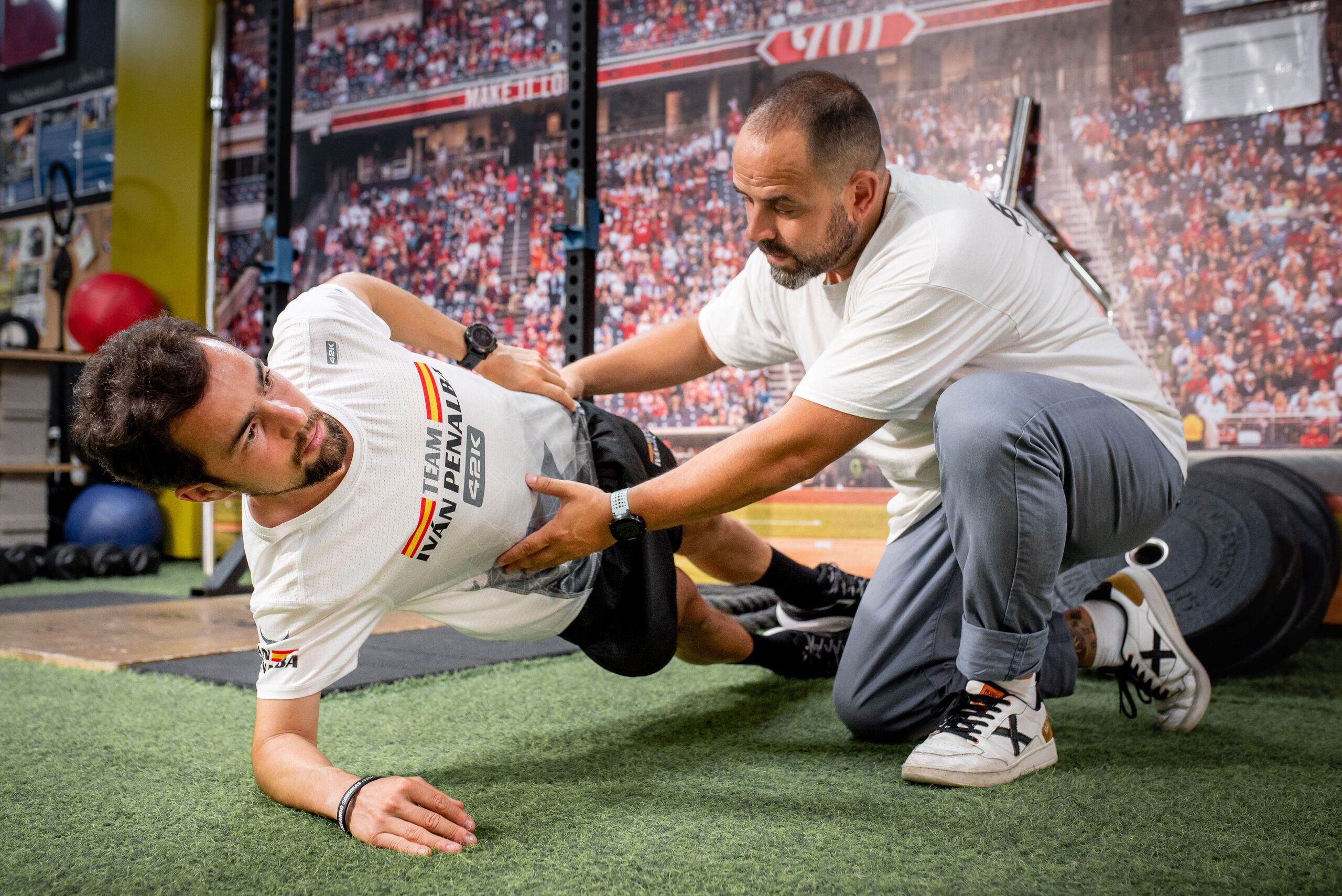
I sincerely believe that the best advice I can give is to put yourself in the hands of a qualified physical-sports activity professional to obtain the greatest benefits (and in the shortest possible time) from strength training, but I know that someone will feel disappointed if they do not I get "wet" at least a little, so here are a few tips that I consider necessary.
- Do not copy routines or plans other people's strength training. Someone who has been training for a long time can do exercises and move loads that should not be those of someone starting from scratch.
- If you join a gym and start from scratch with strength training, you can request the help of its staff to guide you on the initial routine; If you have already worked on strength before, you can inform them of your sports goals and ask them to recommend suitable exercises for it.
- Perform “classic” compound exercises, that is, those that involve different joints and muscle groups: squats (classic squat and Bulgarian squat), strides (backwards, forwards and sides), glute bridge, dead weight, rowing with bar or with TRX, bench press o Push-ups y dominated (assisted).

- Include plates Yes or yes. There are very different ones and they do not require material, so it is easy to make them even at home. The plates help strengthen the famous 'core' (you can read an article on our blog titled «Core training for runners»), a very important part for any runner. Planks allow you to work many muscles: abdominal, buttocks, shoulders, chest, upper back...
- Be careful with the loads / weights. with strength training our goal should be to gain strength, but not increase muscle volume inadequately.
- How many days of strength training? well at least 2 days a week trying not to be consecutive days.
- How many repetitions and how many series? It's hard to answer this, but a basic rule of thumb for beginners might be 3-4 sets and 10-15 reps. It would be desirable that strength training take us between 30 and 50 minutes and that it be a circuit that allows us to work all the large muscle groups.
- Do not work exclusively the legs. One mistake some people make is thinking that strength training for runners should only focus on leg exercises. You have to do exercises that involve all the large muscles of the body. You have to work the whole body to avoid muscular imbalances.
Bibliography used:
National Committee of Child and Adolescent Sports Medicine. Strength training in kids and adolescents: benefits, risks and recommendations. Arch Argent Pediatric. 2018 Dec 1;116(6):S82-S91. Spanish. doi: 10.5546/aap.2018.s82. PMID: 30525318.
Many runners (and athletes in general) mistakenly think that sports supplementation is very important, most importantly, to improve sports performance. In this article I am going to talk about certain habits or routines that should be part of the life of any runner and that, in general, can be more beneficial for their sports performance than sports supplementation.
In this article I am going to explain 3 healthy habits for runners that, without a doubt, report more benefits from the point of view of sports performance than sports supplementation.
3 healthy habits for runners: more hours of sleep, adequate carbohydrates and correct hydration
All of us who are immersed in the world of sports exercise know one of those people who has a closet at home reserved for the endless sports supplements that he collects. Although it is true that there are several supplements with solid scientific evidence to support them (which we will talk about in future articles in this blog), acquiring one of the rest almost always means wasting our money.
Let's start by clarifying what we mean by 'habit'. In the Health Sciences, and in particular in the behavioral sciences, is considered or called habit to any regularly repeated behavior.
There are many guidelines and habits that can provide us with greater benefits in terms of our sports performance and health without investing the considerable amount of money involved in purchasing sports supplementation. But if I had to point out 3 healthy habits for runners that I consider essential, they would be these:
- Improve sleep hygiene (more hours and better quality of sleep).
- Introduce adequate sources of carbohydrates in the diet.
- Establish a good hydration pattern around exercise.
Improve sleep hygiene, one of the essential healthy habits for runners
Adequate rest, in terms of quantity and quality of hours of sleep, is one of the fundamental pillars for good health and sports performance, although the importance of sleep hygiene in the health of people. And it must be emphasized emphatically that among the essential healthy habits for runners must be the improvement of sleep hygiene.
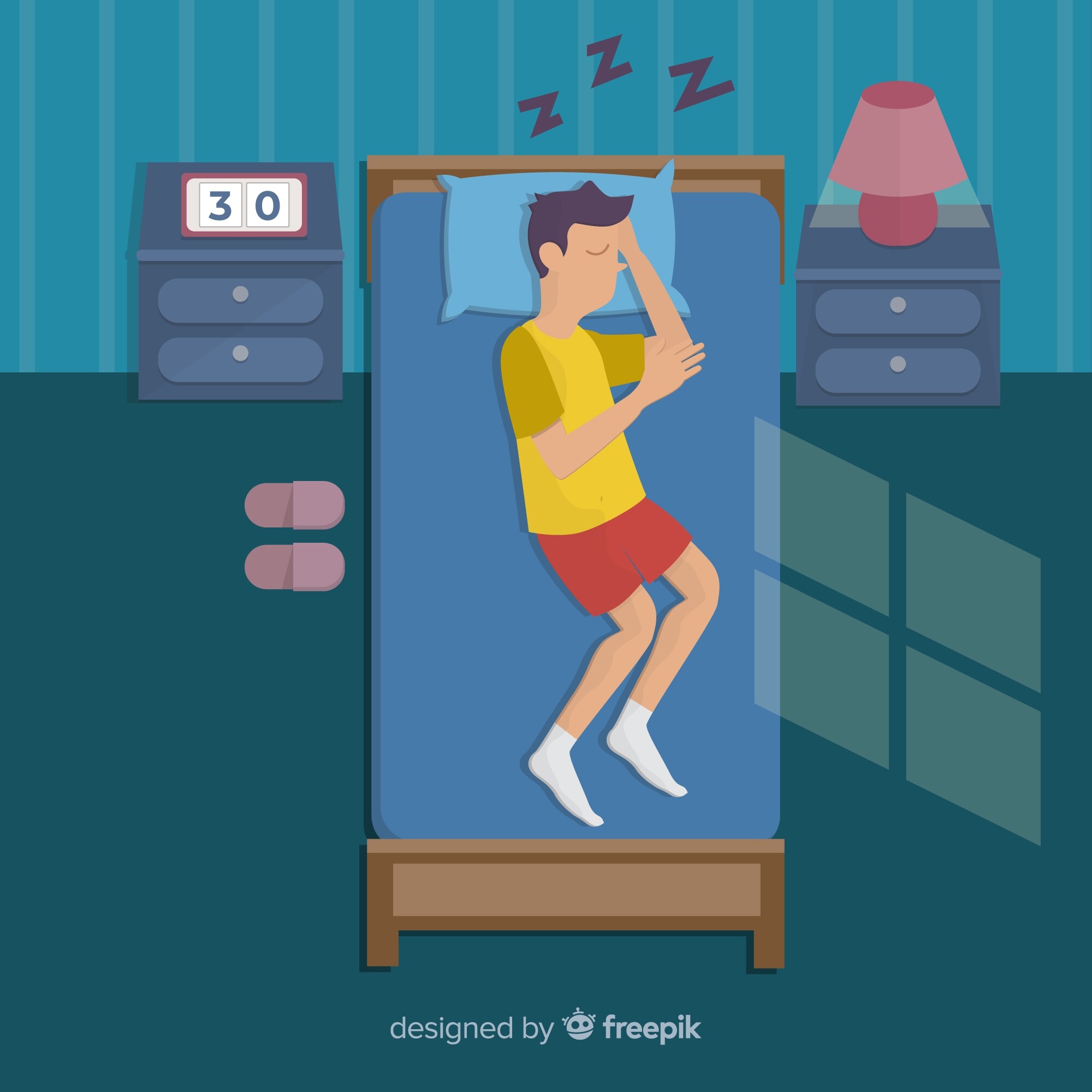
It is evident that there is a problem with lack of sleep in a large part of the population due to factors such as stress, socioeconomic problems and the great epidemic of addiction to electronic devices, including night use.
There is scientific evidence that sleep restriction significantly decreases athletic performance (article: https://pubmed.ncbi.nlm.nih.gov/35708888/), and this worsens as sleep restriction is greater.
Additionally, sleep restriction has been shown to lead to increased caloric intake and abdominal fat gain (article: https://www.jacc.org/doi/abs/10.1016/j.jacc.2022.01.038), probably due to poorer regulation of satiety at the hormonal level. As expected, this will be noticeably negative for our health and sports performance.
Due to the above and other negative consequences of a poor rest, it is especially important to take measures that imply an improvement in sleep hygiene; In other words: you have to do everything possible to sleep more and better. Here are some mandatory recommendations to achieve this goal:
- Establish a pre-bed routine for every day. This can be different for each person, but the common denominator must be the following: prepare physically and mentally for the rest. Soothing sounds or reading a book on paper would be a good idea.
- Avoiding the use of screens 1-2 hours before going to bed would be ideal, since the blue light from these screens inhibits the production of melatonin (sleep-regulating hormone).
- The best conditions for the bedroom are as follows: no noise, as dark as possible, and a slightly low temperature.
Introduce adequate sources of carbohydrates in the diet
The second of the healthy habits for runners that I want to highlight is the incorporation of adequate sources of carbohydrates into the diet.
There are various carbohydrate supplements that can be very useful on many occasions to improve our performance (especially intra-workout, as we saw in a previous article in which we talked about how to lose fat in a healthy way). However, most of our daily carbohydrate intake will be from sources atlimentaries.
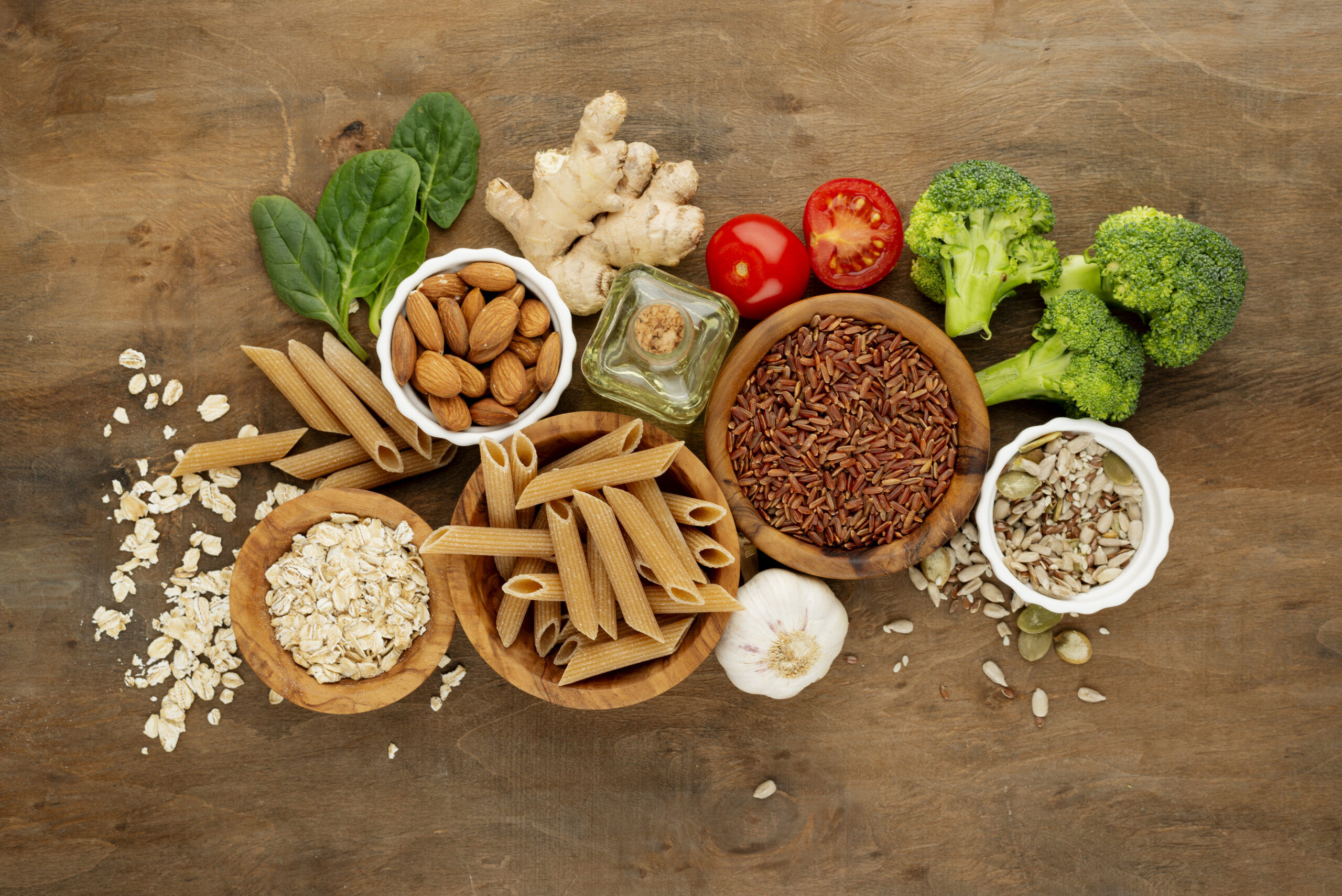
In addition, it is of special importance (mainly for health) that these sources are adequate. What should we understand as adequate sources of carbohydrates? Whole grains, fruits, tubers, and legumes should be the primary sources of carbohydrates to promote optimal health and athletic performance.
Some examples of these groups of alimeTips and advice to introduce them into the diet as one of the healthy habits for runners:
- Whole grains: whole wheat pasta, quinoa, brown rice, corn and oats. For snacks, it is a good idea to prepare a bowl of oatmeal with micro-based vegetable milk, later adding fruit or nuts, for example. In the main meals you can prepare a salad with whole wheat pasta as a base.
- Fruits: the typical ones such as banana, orange or apple, but also other less common ones such as blueberries, pomegranate or persimmon. Both snacks and dessert are ideal.
- Tubers: potato, sweet potato or cassava. In cooked or baked, for example.
- Legumes: chickpeas, lentils, edamame, black beans, etc. In stews it is typical, but in salads it is also a very good idea.
Establish a good hydration pattern around exercise
A good hydration pattern is another of the healthy habits for runners to keep in mind.
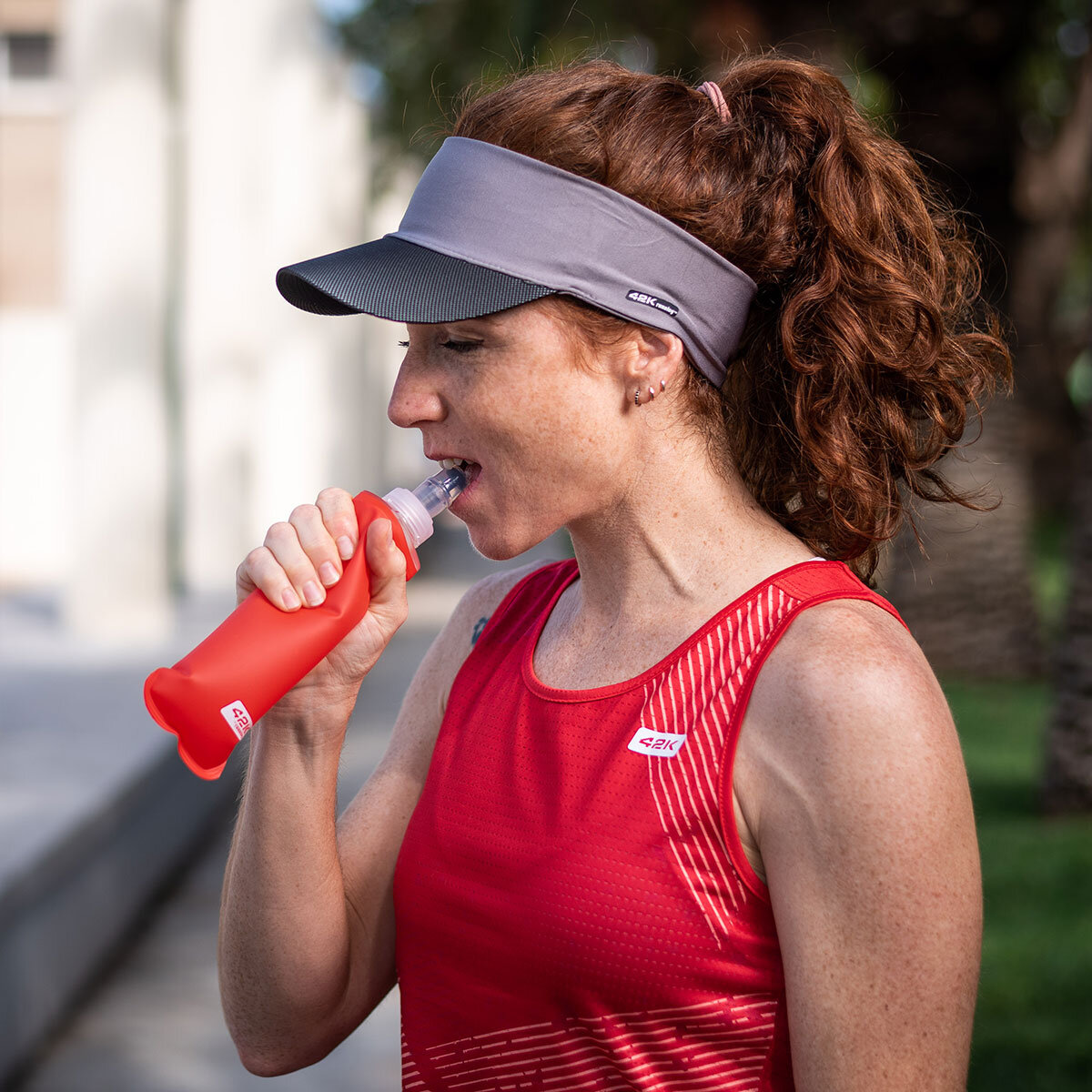
We all know someone who readily states that they never, or barely, consume fluids during training. This is far from adequate, since a good peri-workout hydration regimen will maintain our performance optimally and avoid health problems associated with dehydration.
A person who practices sports regularly, especially in the case of running, and who does not follow adequate hydration guidelines is putting their sports performance at risk. Correct and adequate hydration is one of the healthy habits for runners that I consider essential.
In addition to water, it is important at certain times that the drink also contains added sodium and carbohydrates, such as intra-workout (article: https://onlinelibrary.wiley.com/doi/10.1002/cphy.c130014). Although there are sports supplement preparations that make it easier for us to prepare, it can be perfectly prepared with homemade ingredients. Something to keep in mind is that it is important to individualize the amounts of water, carbohydrates and sodium, especially during training.
Among other factors to take into account we have the sweat rate, which we will talk about in future articles on this blog. Here are some general guidelines for peri-workout hydration.
- Pre-workout: 500 ml of water + a small pinch of common salt about 30 minutes before.
- Intra-workout: (Important, per HOUR): 500-750 ml of water + a pinch of common salt + 30 g of sugar.
- Post-workout: 500-750 ml of water + a pinch of salt or include somelimevery salty
In conclusion, there are healthy habits for runners that must be taken into account. Training is essential to improve performance for any runner, but great value must be placed on incorporating healthy habits that will contribute to greater and more effective performance improvement.
Many runners, especially when they start in the running, have doubts about how to lose fat in a healthy way and also getting their sports performance to improve (and not get worse). In this article the nutritionist Mario Cotanda offers 3 tips for runners who set themselves the goal of losing fat effectively and also improving their performance when running.
3 tips to lose fat in a healthy way and boost your performance
In general, losing fat or reducing the percentage of fat (as long as it is done in a healthy way and, if possible, with the help of a nutrition professional), has the potential to improve your performance to a greater or lesser extent.
When we set ourselves the goal of losing fat, we need to maintain a prolonged caloric deficit over time; How long would it take to prolong a caloric deficit to start losing fat? Well, in general, at least 1 month.
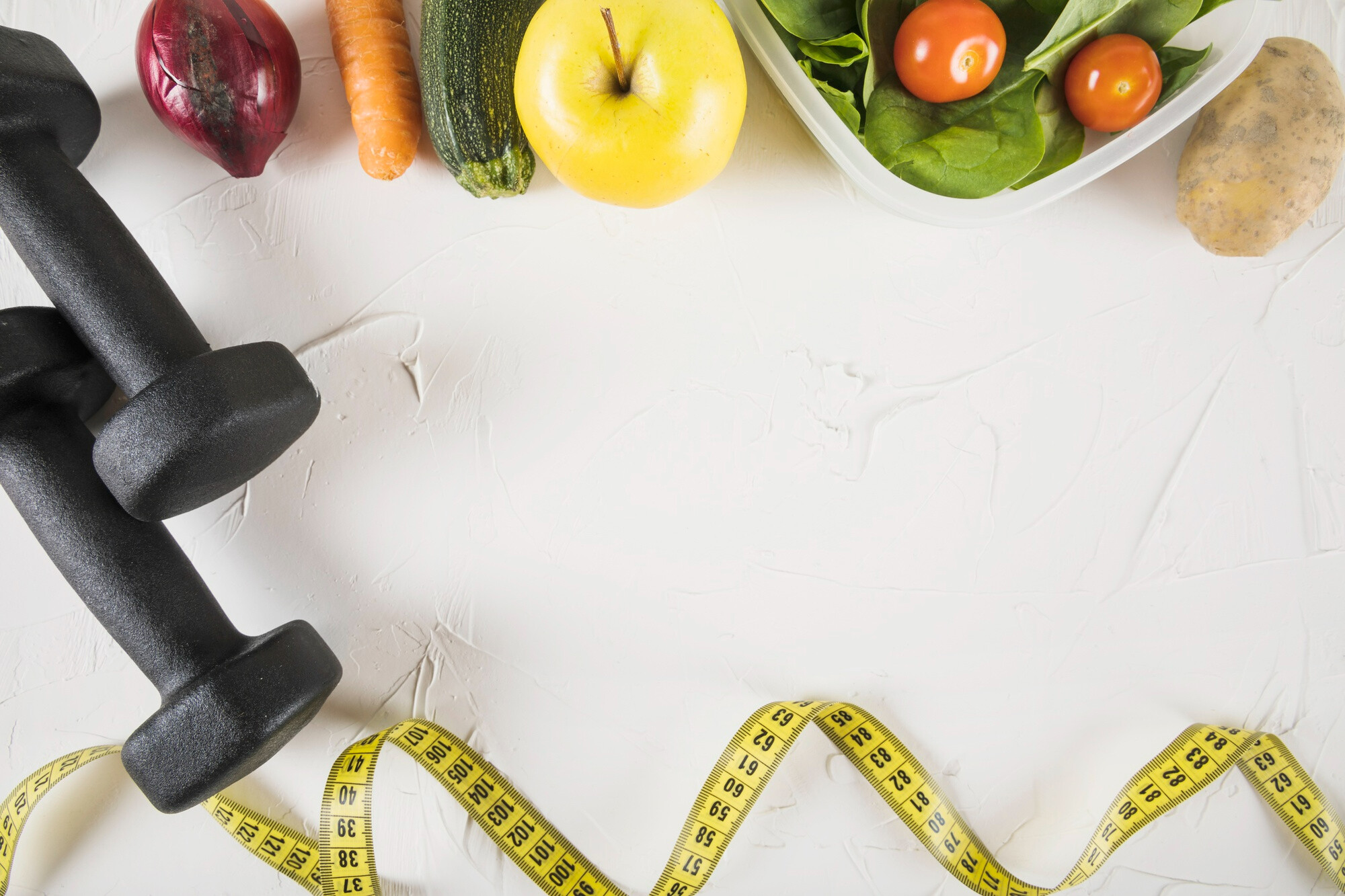
Below are 3 important tips that will help us maintain this state in a healthy and sustainable way, trying to Always stay away from diets or miracle advice that are seen every day on social reds, television or other media.
- Stay active beyond training.
- Nutrition well around exercise (before, during and after).
- eat more atlimeWhole-grain vegetables.
To lose fat… stay active beyond training
In general, there is a somewhat distorted view of what is considered a active lifestyle. People tend to think that simply including a training session is enough to lose fat, but this is far from the truth. When the general context is a sedentary daily routine (working sitting down, moving by car, always using the elevator...) one training session is not enough to have a healthy lifestyle or to achieve goals such as losing body fat.
Be active during your day to day It will allow you to have a higher total daily energy expenditure, thus facilitating being in a state of energy deficit and, therefore, the loss of body fat.
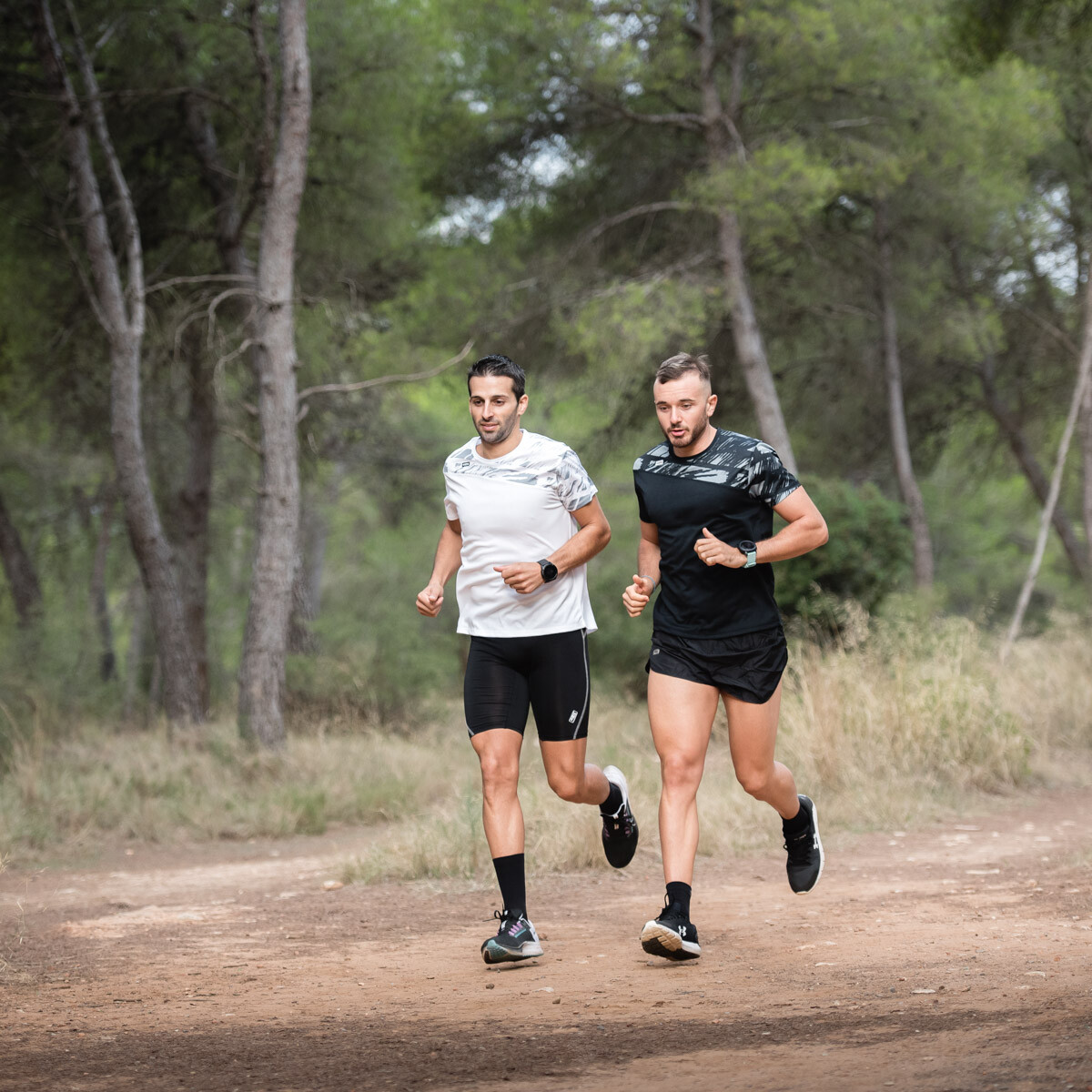
How can I be more active on a day-to-day basis? Well, there are many shapes: take a walk (walk whenever you have the opportunity instead of using the car for any displacement), have active breaks at work (“active breaks” should be 5 minutes every 2 or 3 hours) or use the stairs instead of the elevator when we have to climb stairs are some ways to increase your daily activity and therefore energy expenditure.
Therefore, do not forget: if you want to lose fat, it is not enough to include a training session, you should try to stay active throughout the day to increase your energy consumption and thus favor the decrease in the percentage of body fat.
To lose fat… eat well around exercise
Energy demands during exercise are considerably higher than at rest, especially during resistance training. For this reason, meeting these demands during peri-training (before, during and after) is important.
Some of the advantages of this practice compared to not ingesting adequate nutrients during peri-workout are: session performance improvement, higher recovery for subsequent sessions y better regulation of hunger/satiety mechanisms in the rest of the day. The latter will allow us to more comfortably achieve a state of caloric deficit and therefore, as we have said before, lose body fat.

Something important to keep in mind is that peri-workout intake will depend largely on the level of the person, the characteristics of the session and the intake of aliments in the rest of the day.
Below are some general intake guidelines in peri-workout:
- Before (1 hour before the start of the exercise): include some source of carbohydrates such as one or two pieces of fruit. If a full meal has been eaten in the previous 3 hours, it would not be necessary.
- During: include in the intra-workout drink (we will talk about this in future articles) some source of powdered carbohydrates, such as maltodextrin, which is cheap and can be found in any supplement store. 30 g per 500 ml of water is a good choice. If the training is low intensity, you can also include some easy-to-eat fruit such as bananas.
- After: if we have the possibility of making a complete meal, it is a very good option (include a source of carbohydrate such as whole wheat pasta, potato, quinoa or sweet potato, a source of protein such as legumes and accompany it with a good amount and variety of vegetables such as lettuce, tomato, carrot, cucumber, nuts, etc., including a fruit for dessert if desired). In the event that a snack suits us better due to schedule convenience, we can include, for example, soy yogurt, nuts, bananas and raspberries.
To lose fat… eat more oftenlimeWhole Vegetables
Include more of whole vegetables in your day to day has multiple benefits, among them the decreased risk of disease and mortality for all causes.
In addition, for the topic at hand, which is how to lose fat in a healthy way, we found that whole vegetables increase satiety significantly and therefore allow us to be in caloric deficit more easily.

Among the whole vegetables we find: whole grains (whole wheat pasta, quinoa, brown rice…), vegetables, fruits, vegetables, nuts y tubers (potato, sweet potato…). The only consideration we should have would be to avoid including these atliments at the pre and intra-workout moment due to its greater amount of fiber that makes digestion difficult (if 2 hours or more pass since the pre-workout meal, there would be no problem).
Have you taken note? Now is the time to put it into practice. Go for all!
There are many runners and runners who have doubts about the consumption of carbohydrates. In this article we are going to talk about the carbohydrates that you should eat and those that you should avoid on a regular basis and only consume them occasionally. We are going to try to shed light on the dreaded (for many athletes) carbohydrates.
because yes, there is alimehealthy nts and highly recommended with carbohydrates that must be present in the diet of athletes and especially runners who carry out significant loads of kilometers throughout the week.
The carbohydrates they are an important nutrient which is talked about a lot in society and, on many occasions, with a lot of ignorance. As a consequence of this, in consultations with dietitians-nutritionists we find that there are many myths very widespread regarding their consumption: if they are bad, if they make you fat, if they should not be taken at night, if they should be avoided to lose weight, etc.
Well, we are going to shed a little light on carbohydrates (HC) in order to help you improve your eating habits.limentarios as well as your sports performance.
AlimeFoods rich in carbohydrates: fruit, vegetables, legumes, pasta, rice, cereals, bread...
Before indicating the carbohydrates that you can (and should) eat and those that should not be part of your diet (and that you should only consume occasionally) we must know how tolimento are carbohydrates. Well, the main groups of alimeFoods rich in carbohydrates are the fruit, vegetables, vegetables, rice, pasta, pan, cereals… and although to a lesser extent they are also present in dairy.
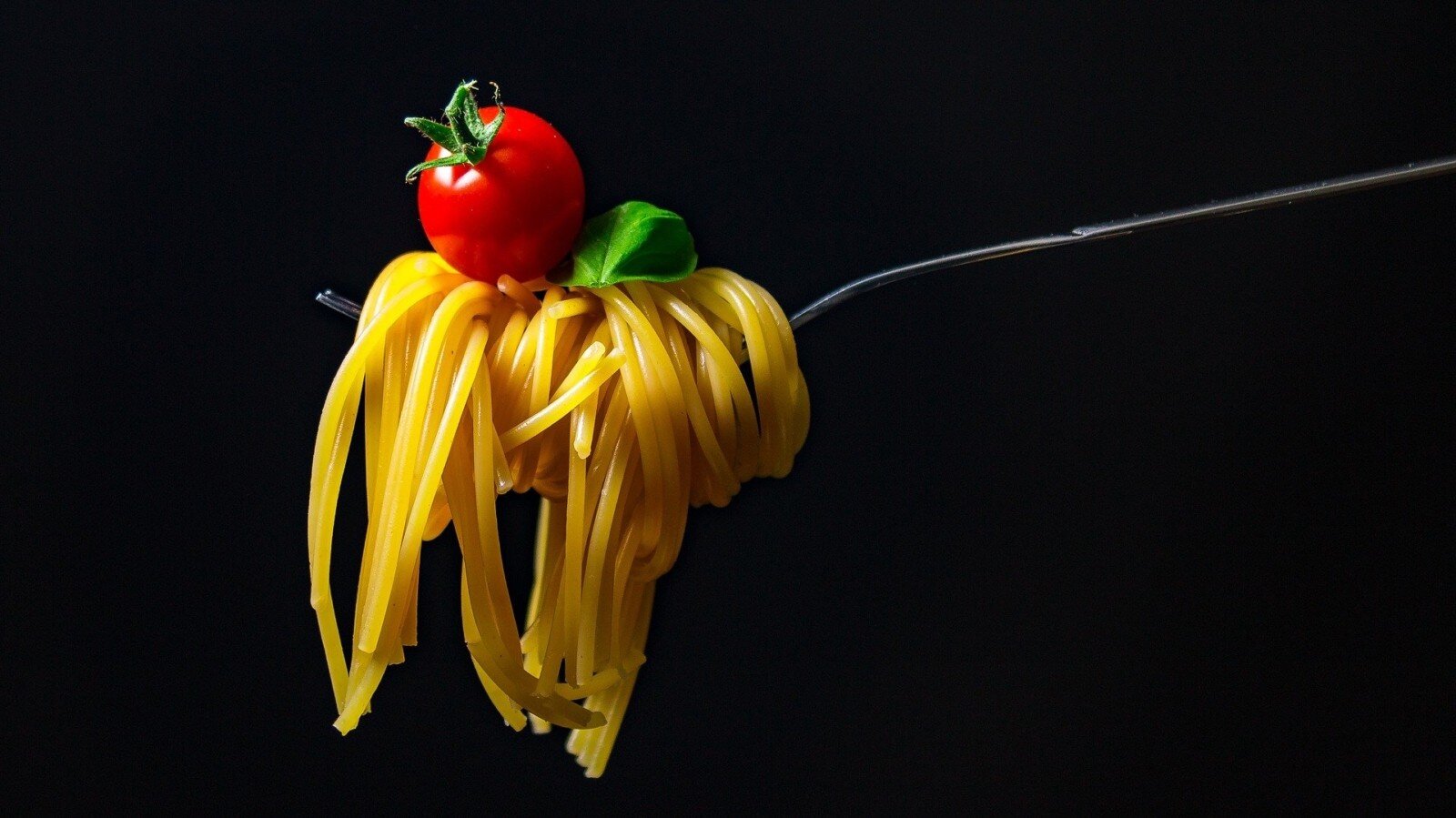
Do you think that a healthy diet should avoidliments like fruit or vegetables? The undoubted answer is "no." Therefore, you should not run away from carbohydrates or be afraid of them. It must be made clear that carbohydrates are necessary for the proper functioning of the body.
And while it is true that there are healthy carbohydrates (fruit, vegetables, legumes, rice, pasta and bread, cereals...) it is also true that there are unhealthy carbohydrates and that we must avoid, as is the case with added sugars, mainly.
Added sugars, the main unhealthy carbohydrates
Added sugars are those that the industrylimentaria added to a certain product; There are many examples of products with added sugars: refreshments, Bakery, processed ice cream, precooked products both sweet and salty commercial juices (they don't really have real fruit juice or if they do it's a ridiculous percentage), Smoothies, candies...
It should be remembered that sugar is an ingredient that is not found in nature and that it is obtained thanks to a process industrial refining and bleaching.
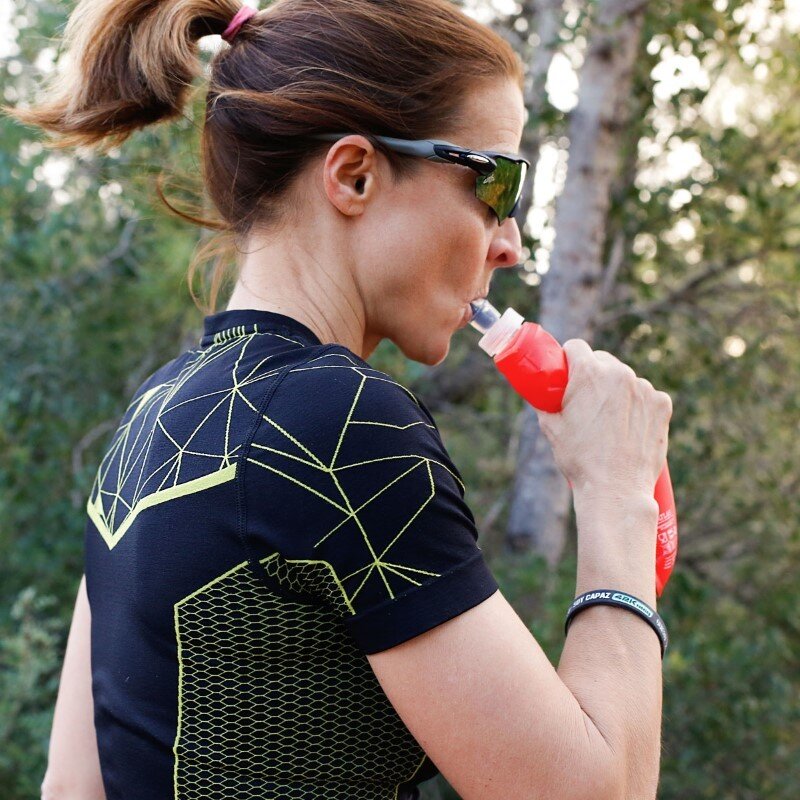
not consume atlimeultra-processed nuts
More than worrying about whether or not a product has carbohydrates, we should worry about not consume tolimeultra-processed nuts. It is not necessary to eliminate them one hundred percent, but almost; their consumption must be very, very, occasional because they contain a large amount of Trans fat, added sugars and flavor enhancers that, in addition to many unnecessary calories, accelerate cell aging, as a study by the University of Navarra published in the journal American Journal of Clinical Nutrition.
According to World Health Organization (WHO), it is aboutlimeThey are very unbalanced nutritionally, and it is that the modifications that their ingredients have suffered make them lack vitamins and minerals, while they have too many calories.
The WHO, in its report on the significant increase in the consumption oflimeUltra-processed foods and their effects on health, he also explains that they are characterized by having an excess of some of the following components:
- Sugars: glucose, sucrose, fructose ...
- Hydrogenated fats
- Saturated fats
- Sal Island
- additives
Between 45-55% of daily calories should come from carbohydrates
The carbohydrates must be consumed dailyIn fact, between 45-55% of daily calories should come from carbohydrates, compared to 15-25% from protein and 30% from fat. But carbohydrates are of special interest to athletes, specifically in endurance and ultra-endurance sports.
An athlete of these characteristics must consume at least 50% of their daily calories in the form of carbohydrates, even reaching 60-65% of the total energy value of the diet at certain times.
When should carbohydrates be taken?
For the whole day. For example, having breakfast with cereals or toast, having lunch with some bread or fruit (idem snack), eating pasta, rice, legumes, potatoes, quinoa, couscous, etc. Fruit will also be an ideal dessert, both at lunch and dinner, and in the case of athletes who require extra carbohydrates, take garnishes at dinner with potatoes, rice or accompany lunch and/or dinner with bread. Don't you know the alimentation runner?
So, you already know that the carbohydrates you should eat are those that are present in a multitude of alimeSome of those that we consider healthy and recommended, while those that you should not take (or if you do, let it be occasionally or very occasionally) are those that are in alimeultra-processed nts.
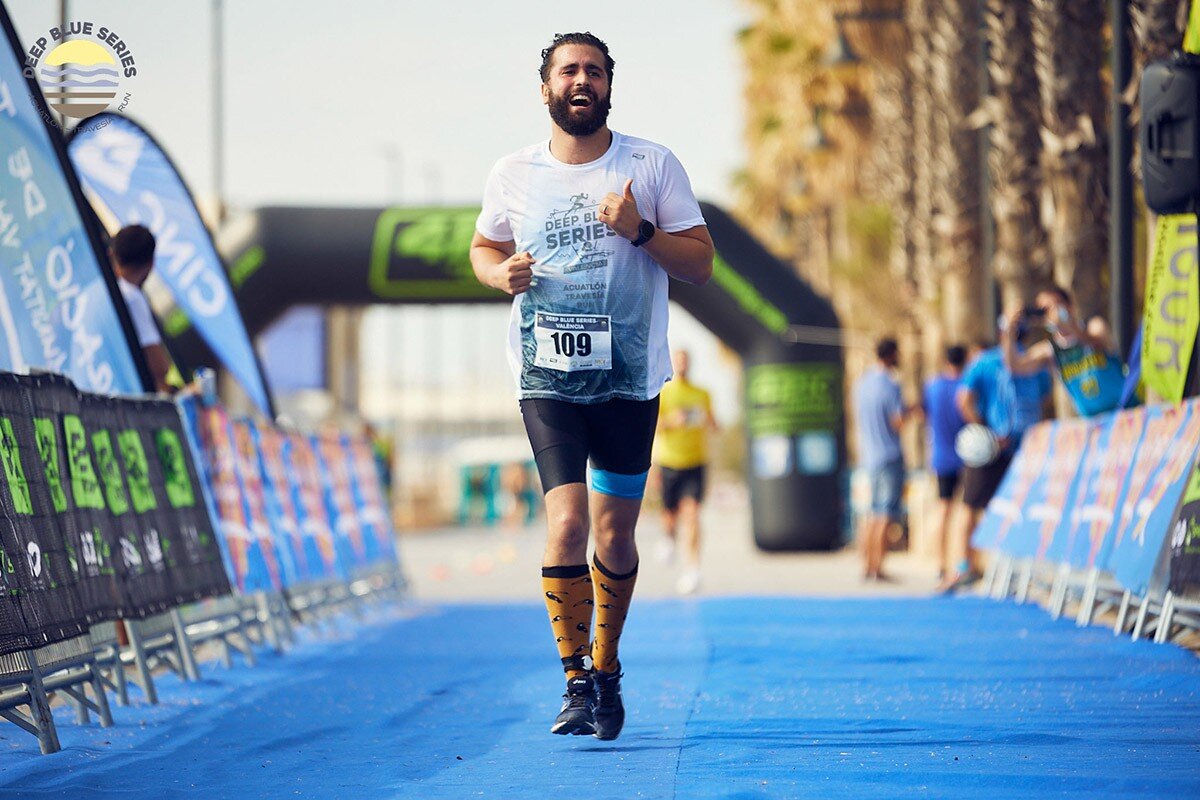
Athletes may also require extra carbohydrates before, during and after training. Furthermore, although we have previously mentioned them aslimeThings to avoid, certain sugars are necessary due to their rapid absorption and digestion. This is the case of honey, jam, quince, isotonic drinks, dried fruits or sports bars and gels. are tolimeSugary snacks, to be avoided except very occasionally by anyone who does not play sports, but necessary for endurance athletes.
The consumption of this type oflimeThese must also be trained, never experienced in a race or competition. For this reason, it is always advisable to go to a registered dietitian-nutritionist, preferably specialized in sports nutrition, so that they can carry out a correct guideline for the dietary plan, taking into account the needs, characteristics and objectives of the patient.
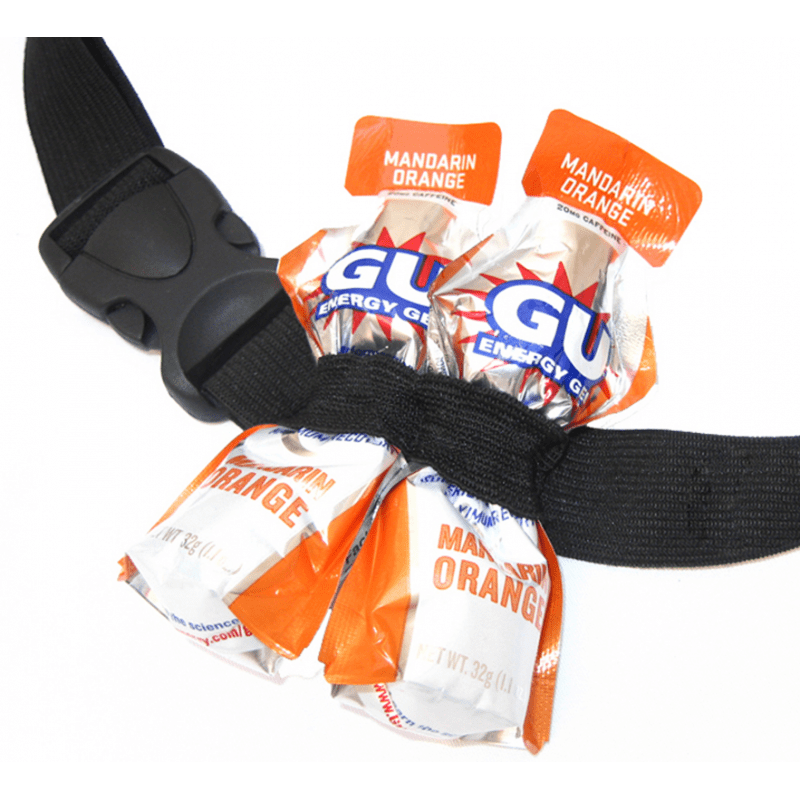
Remember one correct tolimentation is synonymous with health, so going to the corresponding professional is always the best option.
oh! And by the way, when they tell you that carbohydrates are fattening, answer that 1 gram of carbohydrates has exactly the same calories as 1 gram of protein.
As a final reflection, I would like to leave you this sentence: gain weight from excess calories in the diet, not because of poor carbohydrates.
42K · All rights reserved

